Method For Producing Transgenic Plant Having Increased Content Of 20-hydroxyecdysone Using Insect-derived Gene And Plant Produced By The Same
RIU; Key Zung ; et al.
U.S. patent application number 16/759605 was filed with the patent office on 2020-09-24 for method for producing transgenic plant having increased content of 20-hydroxyecdysone using insect-derived gene and plant produced by the same. The applicant listed for this patent is WOOJUNG BIO INC.. Invention is credited to Kyung Hwan BOO, Byung Nyun CHUN, Jiwon KIM, Key Zung RIU, Jung Kyu SUH.
| Application Number | 20200299720 16/759605 |
| Document ID | / |
| Family ID | 1000004929589 |
| Filed Date | 2020-09-24 |
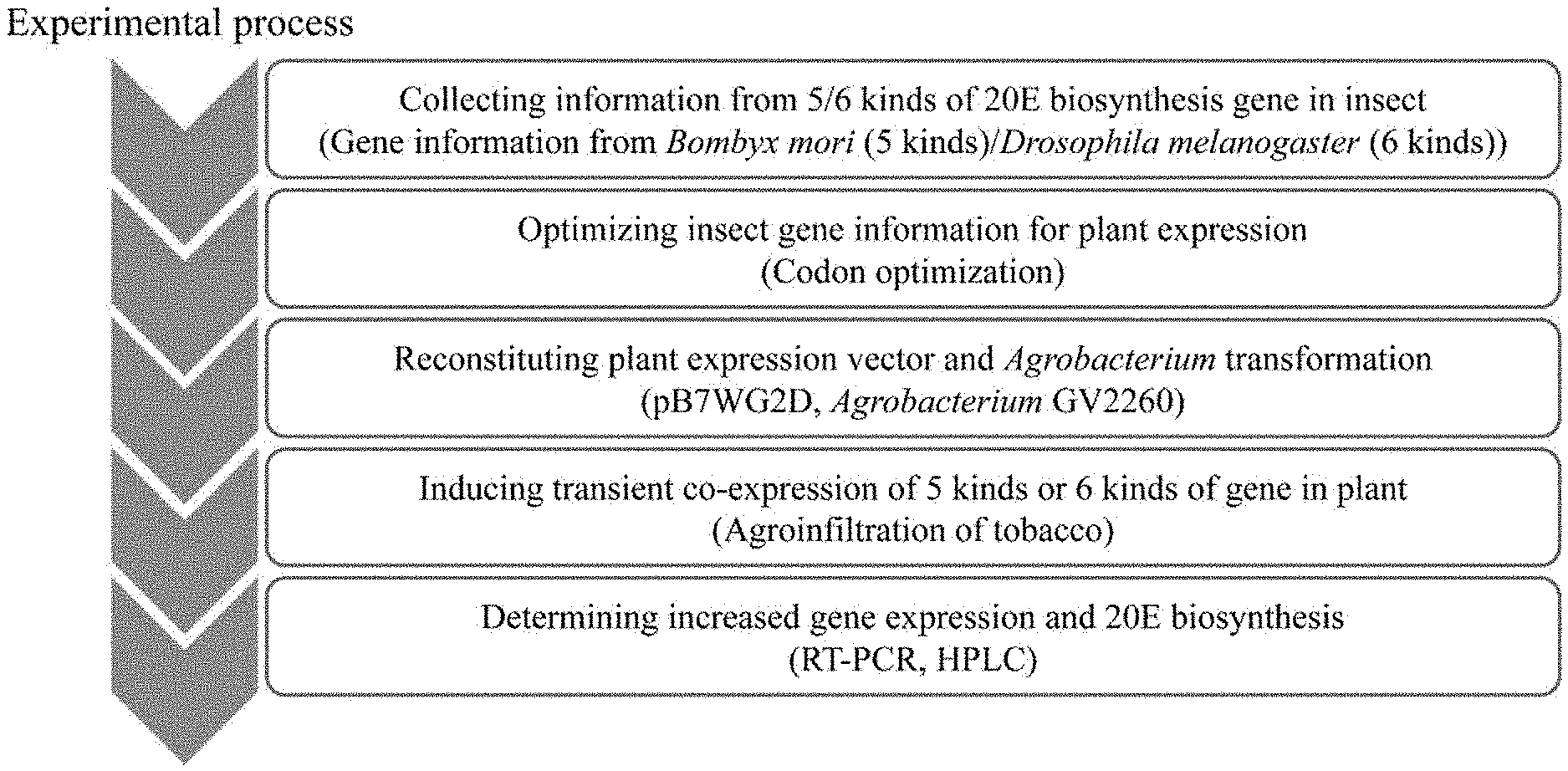
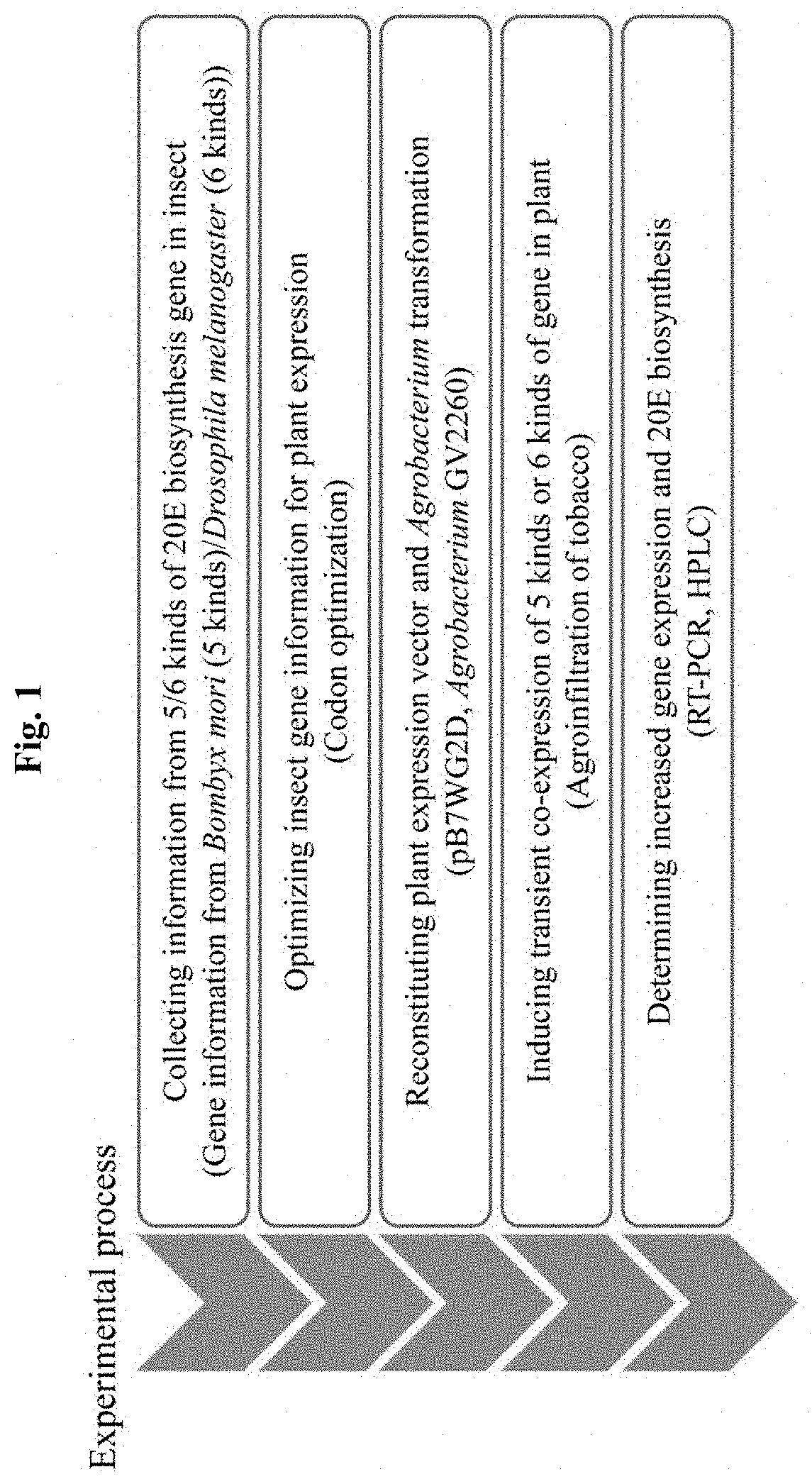
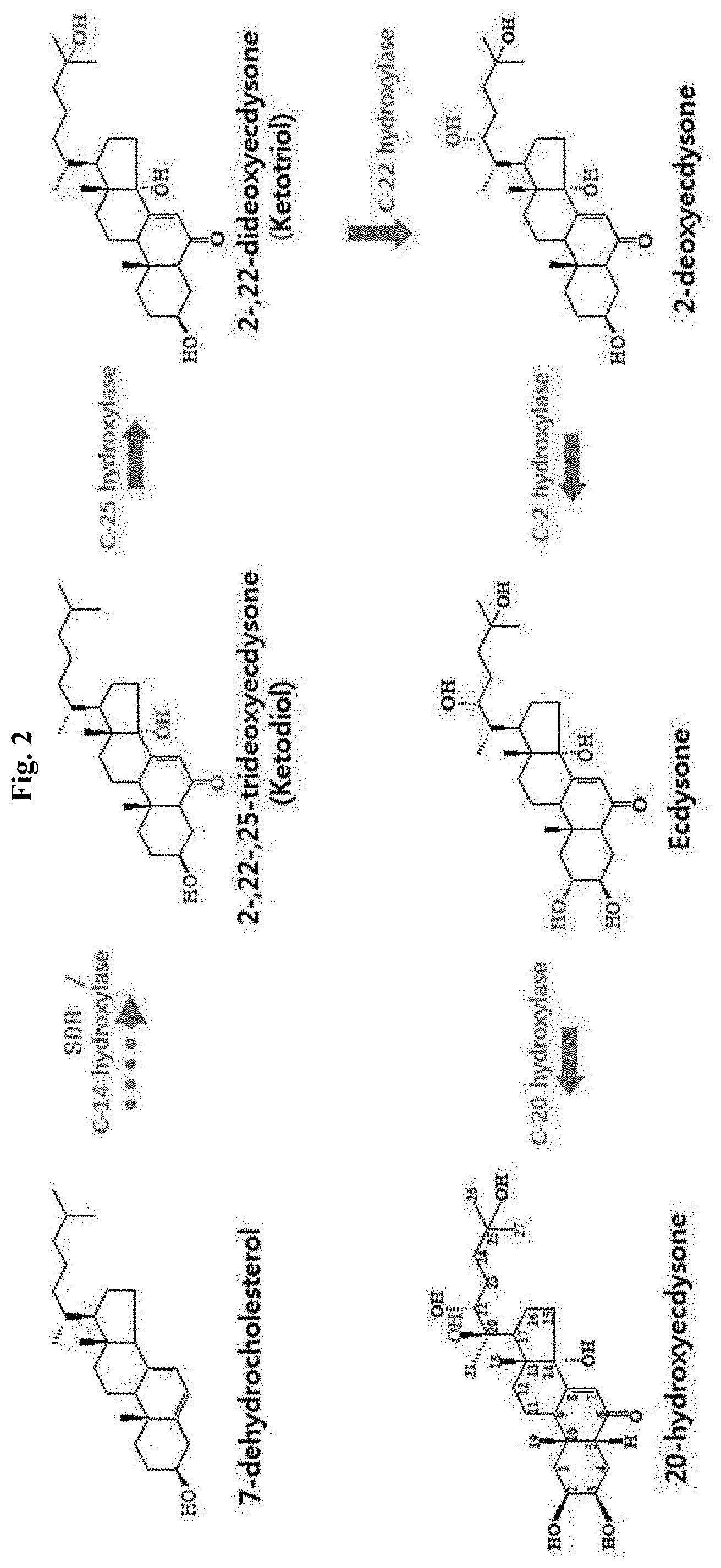
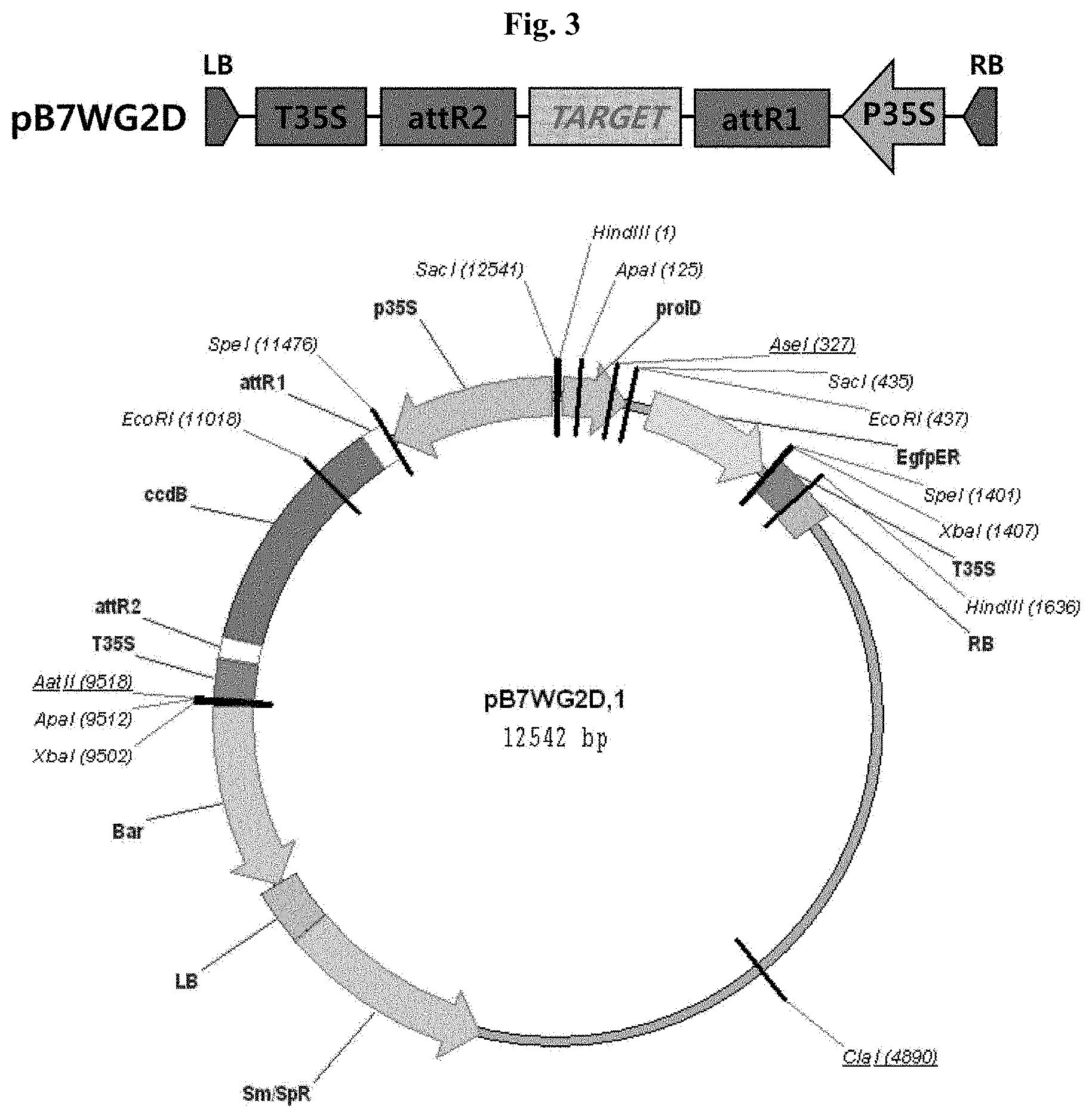
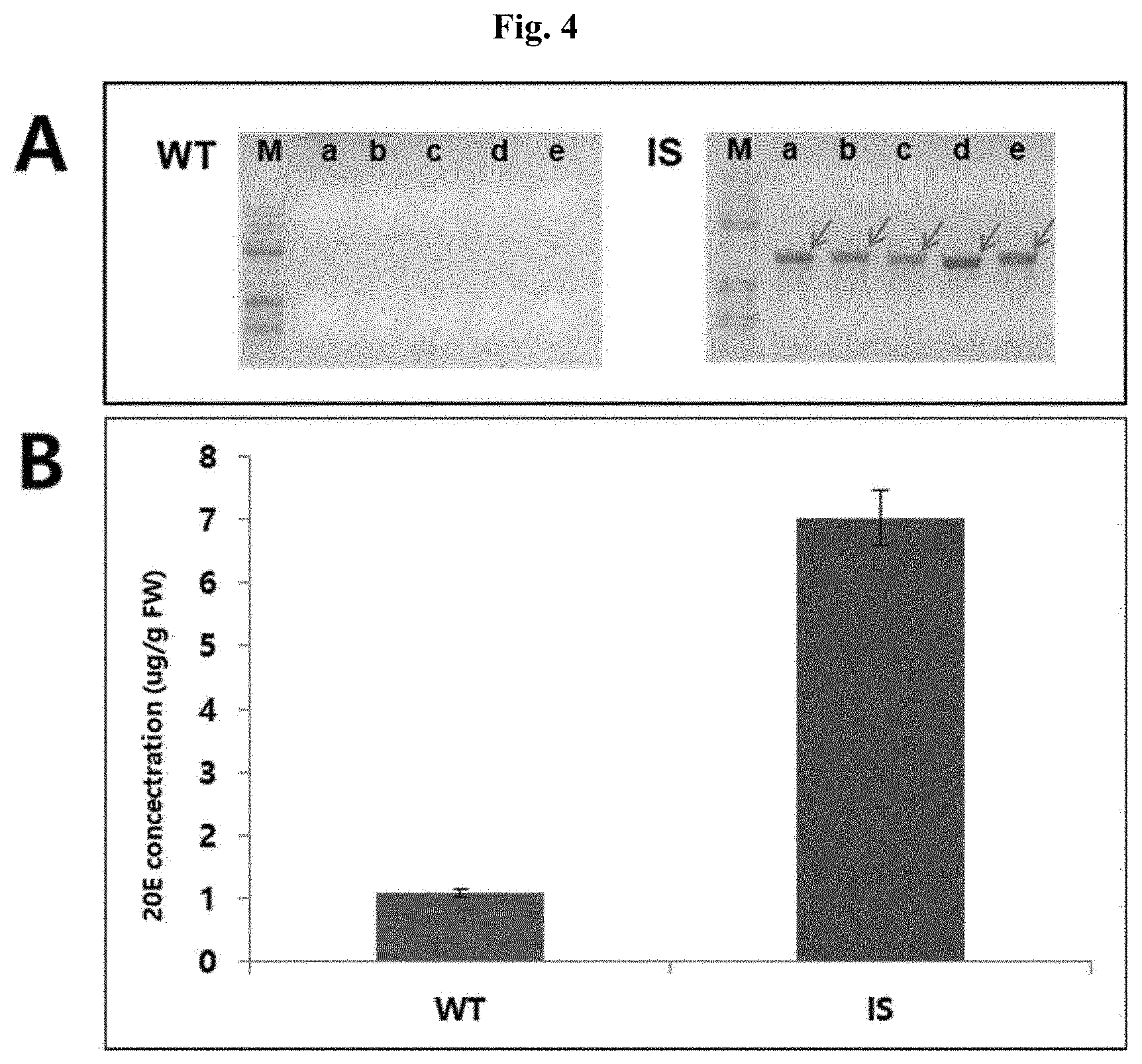
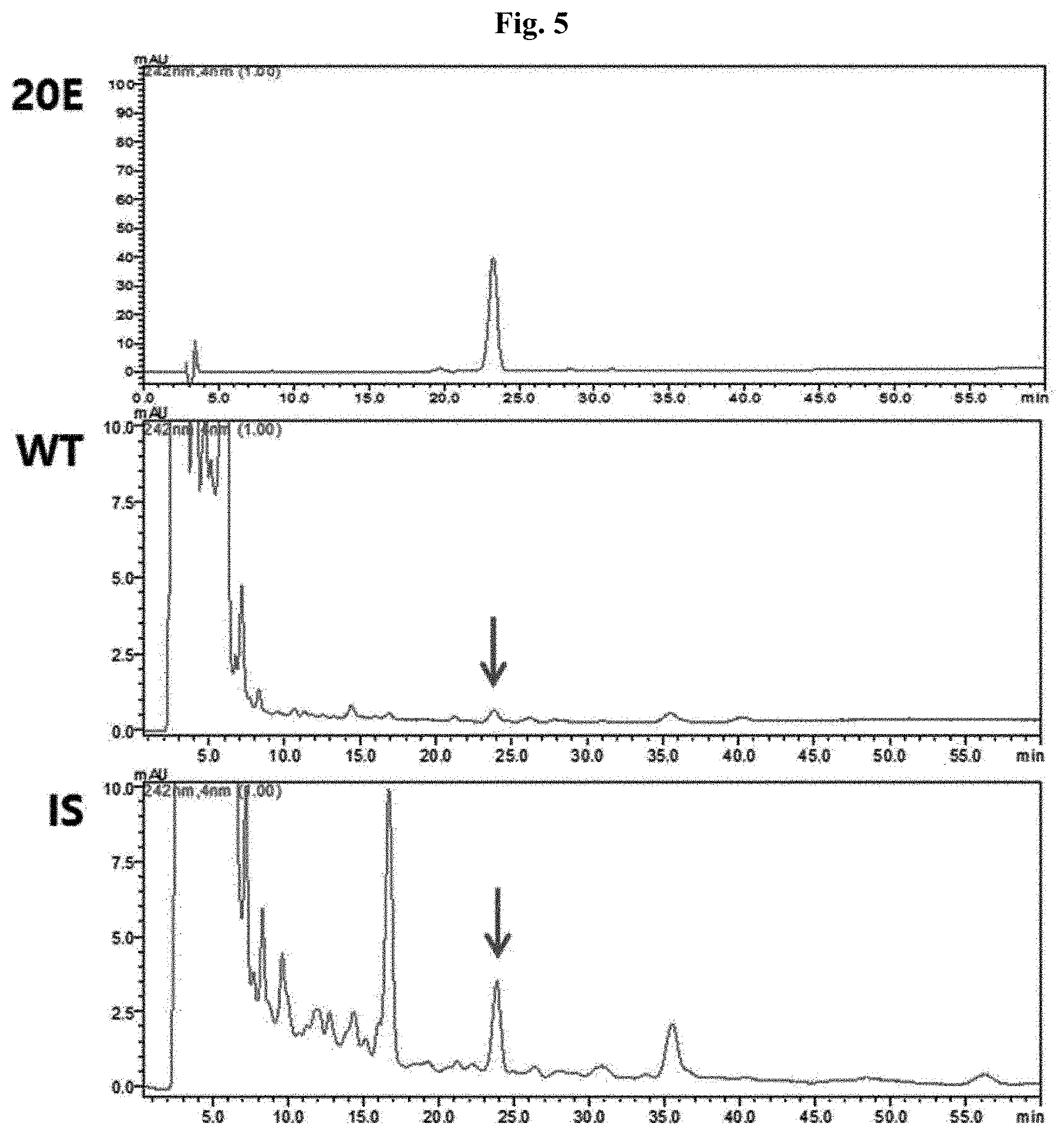
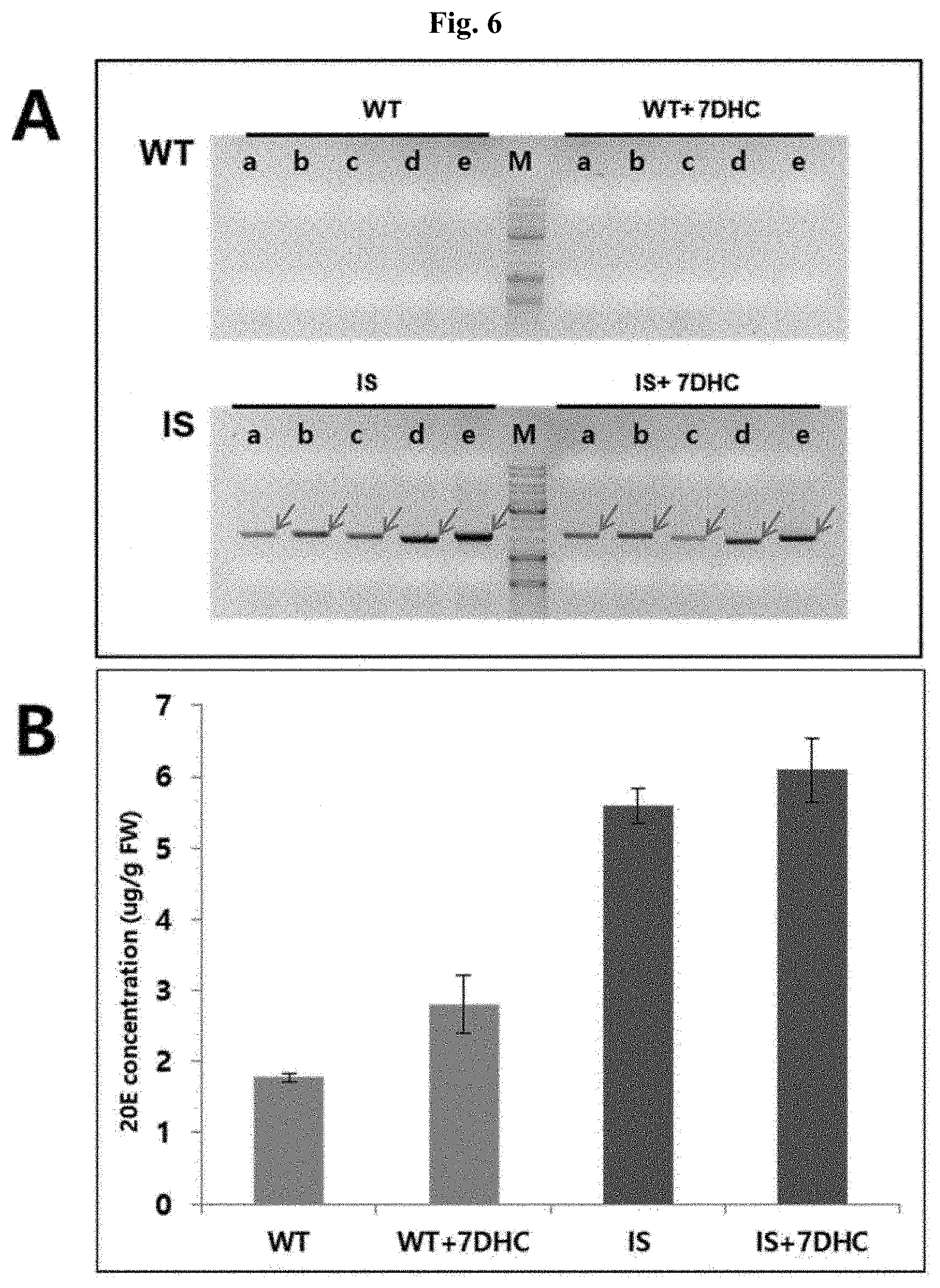
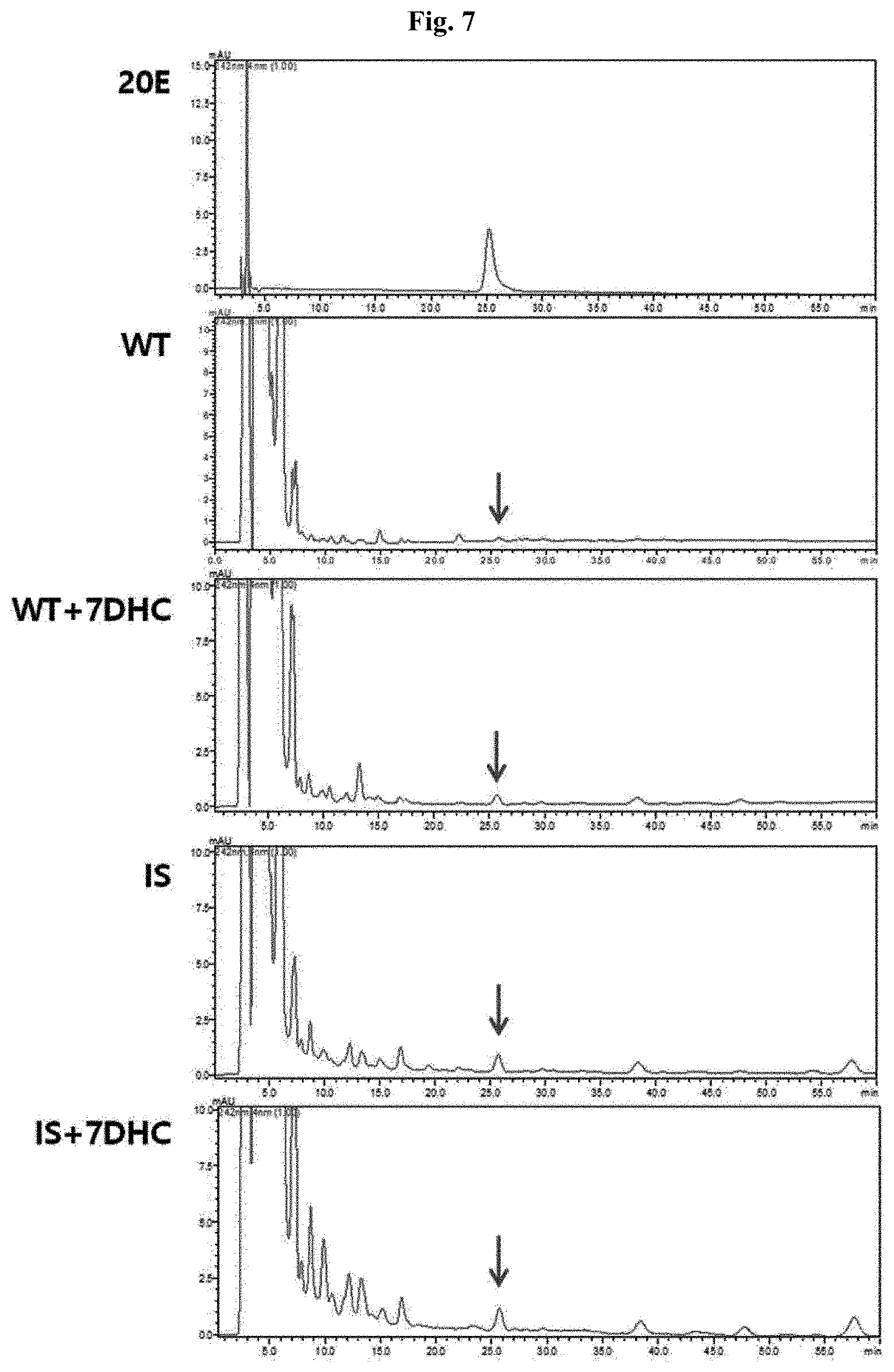
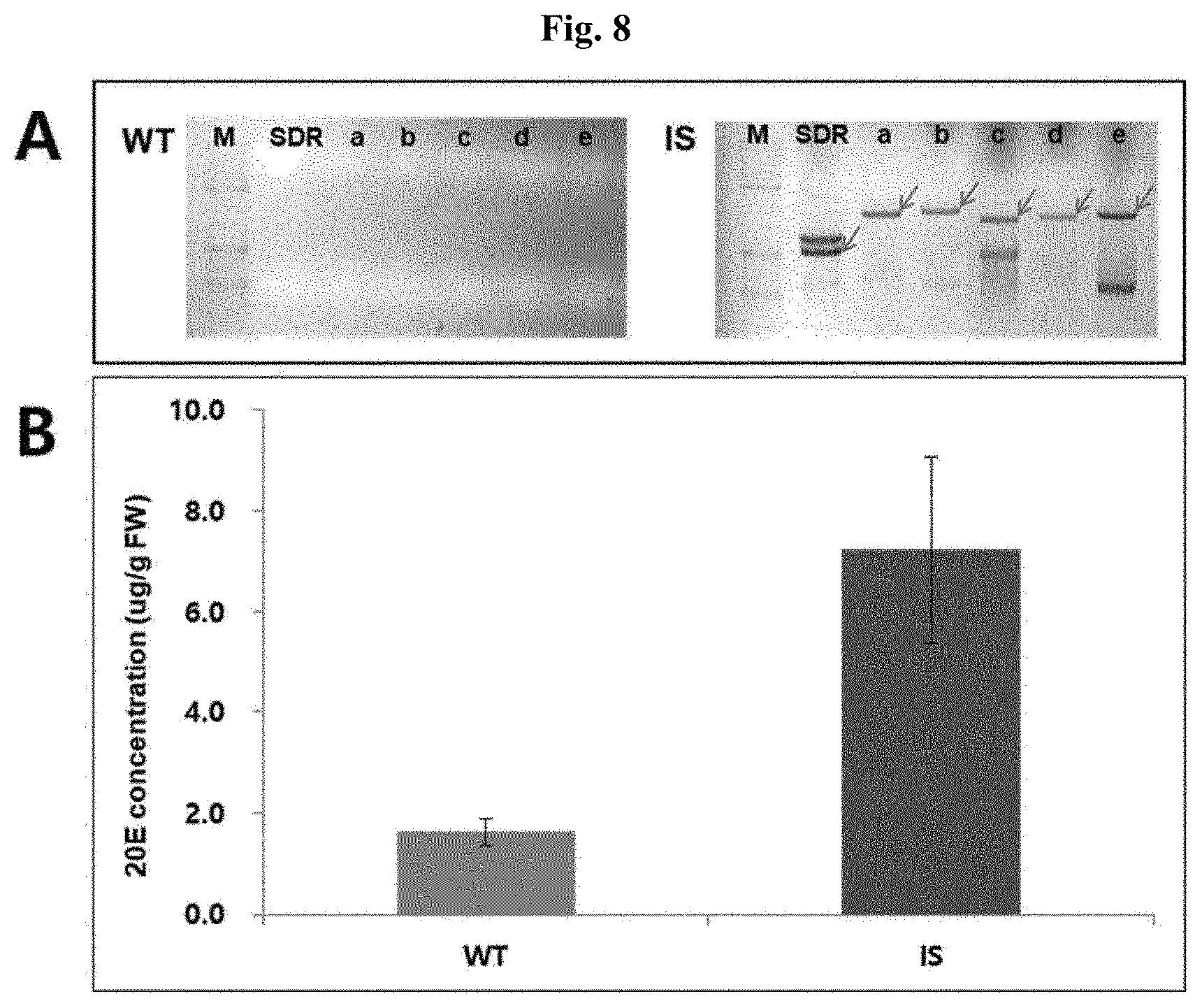
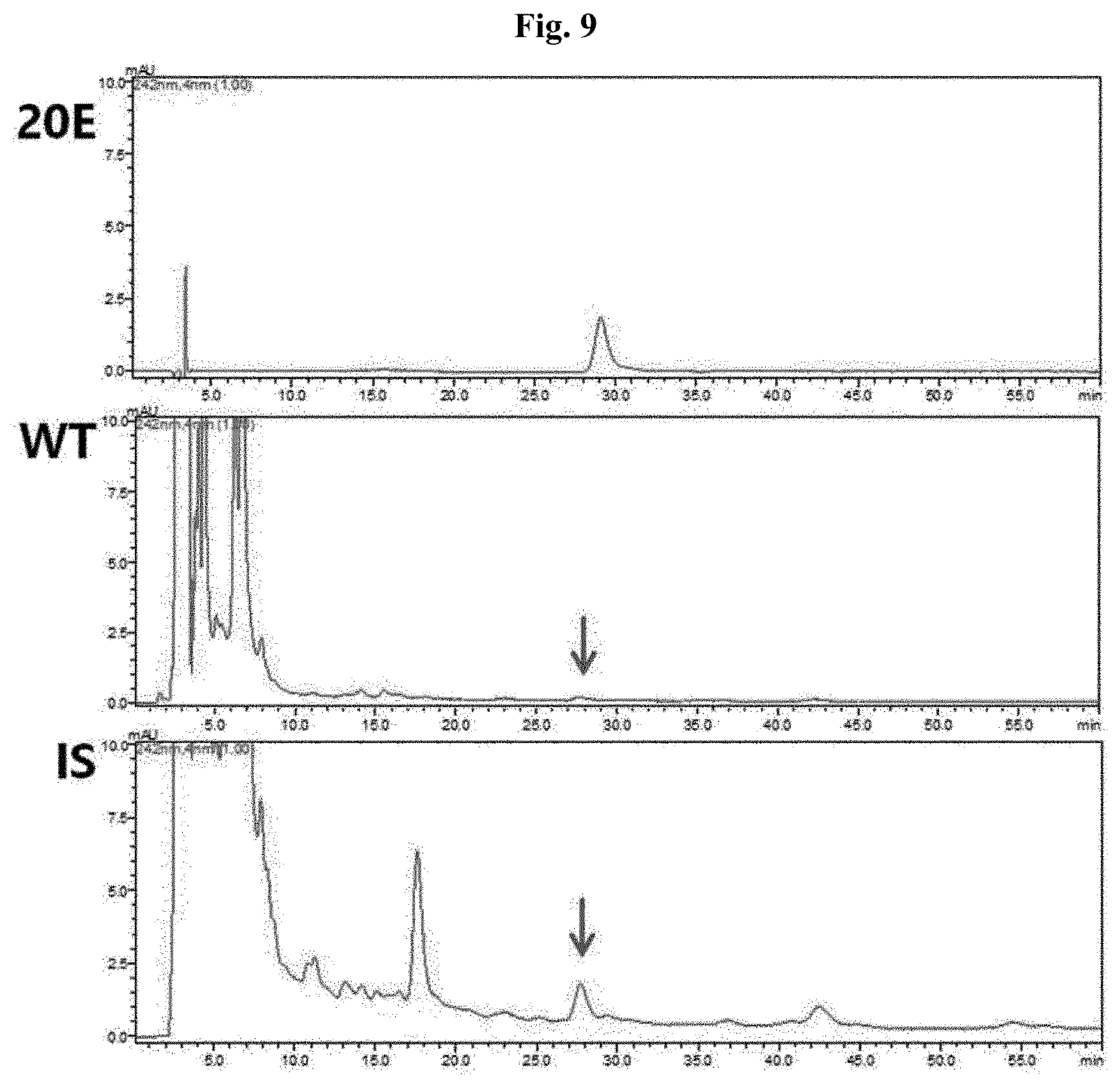
View All Diagrams
| United States Patent Application | 20200299720 |
| Kind Code | A1 |
| RIU; Key Zung ; et al. | September 24, 2020 |
METHOD FOR PRODUCING TRANSGENIC PLANT HAVING INCREASED CONTENT OF 20-HYDROXYECDYSONE USING INSECT-DERIVED GENE AND PLANT PRODUCED BY THE SAME
Abstract
A method for producing a transgenic plant having increased content of 20-hydroxyecdysone according to an embodiment of the present invention may use insect-derived gene A method according to an embodiment of the present invention includes transforming a plant cell with a recombinant vector including at least one of a gene encoding short-chain dehydrogenase/reductase (SDR) protein and a gene encoding C-14 hydroxylase protein, a gene encoding C-25 hydroxylase protein, a gene encoding C-22 hydroxylase protein, a gene encoding C-2 hydroxylase protein, and a gene encoding C-20 hydroxylase protein derived from insect, and regenerating a plant from the transformed plant cell.
| Inventors: | RIU; Key Zung; (Jeju-do, KR) ; BOO; Kyung Hwan; (Jeju-do, KR) ; CHUN; Byung Nyun; (Gyeonggi-do, KR) ; SUH; Jung Kyu; (Gyeonggi-do, KR) ; KIM; Jiwon; (Jeju-do, KR) | ||||||||||
| Applicant: |
|
||||||||||
|---|---|---|---|---|---|---|---|---|---|---|---|
| Family ID: | 1000004929589 | ||||||||||
| Appl. No.: | 16/759605 | ||||||||||
| Filed: | November 1, 2018 | ||||||||||
| PCT Filed: | November 1, 2018 | ||||||||||
| PCT NO: | PCT/KR2018/013177 | ||||||||||
| 371 Date: | April 27, 2020 |
| Current U.S. Class: | 1/1 |
| Current CPC Class: | A01H 6/823 20180501; C12N 15/8243 20130101; C12N 15/8286 20130101; A01H 5/10 20130101 |
| International Class: | C12N 15/82 20060101 C12N015/82; A01H 6/82 20060101 A01H006/82; A01H 5/10 20060101 A01H005/10 |
Foreign Application Data
| Date | Code | Application Number |
|---|---|---|
| Nov 2, 2017 | KR | 10-2017-0145435 |
Claims
1. A method for producing a transgenic plant having increased content of 20-hydroxyecdysone compared to a wild type plant, the method comprising: transforming a plant cell with a recombinant vector comprising: at least one of a gene encoding short-chain dehydrogenase/reductase (SDR) protein and a gene encoding C-14 hydroxylase protein; a gene encoding C-25 hydroxylase protein; a gene encoding C-22 hydroxylase protein; a gene encoding C-2 hydroxylase protein; and a gene encoding C-20 hydroxylase protein derived from insect; and regenerating a plant from the transformed plant cell.
2. The method of claim 1, wherein the gene encoding SDR protein consists of the nucleotide sequence of SEQ ID NO: 1 or SEQ ID NO: 7; the gene encoding C-14 hydroxylase protein consists of the nucleotide sequence of SEQ ID NO: 2 or SEQ ID NO: 8; the gene encoding C-25 hydroxylase protein consists of the nucleotide sequence of SEQ ID NO: 3 or SEQ ID NO: 9; the gene encoding C-22 hydroxylase protein consists of the nucleotide sequence of SEQ ID NO: 4 or SEQ ID NO: 10; the gene encoding C-2 hydroxylase protein consists of the nucleotide sequence of SEQ ID NO: 5 or SEQ ID NO: 11; and the gene encoding C-20 hydroxylase protein consists of the nucleotide sequence of SEQ ID NO: 6 or SEQ ID NO: 12.
3. A transgenic plant produced by the method of claim 1, the transgenic plant having increased content of 20-hydroxyecdysone compared to the wild type plant.
4. A transgenic seed of the transgenic plant according to claim 3.
5. A composition for increasing content of 20-hydroxyecdysone in plant, the composition comprising: at least one of short-chain dehydrogenase/reductase (SDR) gene which consists of the nucleotide sequence of SEQ ID NO: 1 or SEQ ID NO: 7 and C-14 hydroxylase gene which consists of the nucleotide sequence of SEQ ID NO: 2 or SEQ ID NO: 8; C-25 hydroxylase gene which consists of the nucleotide sequence of SEQ ID NO: 3 or SEQ ID NO: 9; C-22 hydroxylase gene which consists of the nucleotide sequence of SEQ ID NO: 4 or SEQ ID NO: 10; C-2 hydroxylase gene which consists of the nucleotide sequence of SEQ ID NO: 5 or SEQ ID NO: 11; and C-20 hydroxylase gene which consists of the nucleotide sequence of SEQ ID NO: 6 or SEQ ID NO: 12.
6. (canceled)
7. A method for producing a transgenic plant having increased insect resistance compared to a wild type plant, the method comprising: transforming a plant cell with a recombinant vector comprising: at least one of a gene encoding short-chain dehydrogenase/reductase (SDR) protein and a gene encoding C-14 hydroxylase protein; a gene encoding C-25 hydroxylase protein; a gene encoding C-22 hydroxylase protein; a gene encoding C-2 hydroxylase protein; and a gene encoding C-20 hydroxylase protein derived from insect; and regenerating a plant from the transformed plant cell.
8. A transgenic plant produced by the method of claim 7, the transgenic plant having increased insect resistance compared to the wild type plant.
9. A transgenic seed of the transgenic plant according to claim 8.
10. (canceled)
11. The method of claim 1, wherein the least one comprises the gene encoding short-chain dehydrogenase/reductase (SDR) protein.
12. The method of claim 1, wherein the least one comprises the gene encoding C-14 hydroxylase protein.
13. The method of claim 1, wherein the least one comprises both the gene encoding short-chain dehydrogenase/reductase (SDR) protein and the gene encoding C-14 hydroxylase protein.
14. The method of claim 12, wherein the gene encoding C-14 hydroxylase protein consists of the nucleotide sequence of SEQ ID NO: 2; the gene encoding C-25 hydroxylase protein consists of the nucleotide sequence of SEQ ID NO: 3; the gene encoding C-22 hydroxylase protein consists of the nucleotide sequence of SEQ ID NO: 4; the gene encoding C-2 hydroxylase protein consists of the nucleotide sequence of SEQ ID NO: 5; and the gene encoding C-20 hydroxylase protein consists of the nucleotide sequence of SEQ ID NO: 6.
15. The method of claim 13, wherein the gene encoding SDR protein consists of the nucleotide sequence of SEQ ID NO: 7; the gene encoding C-14 hydroxylase protein consists of the nucleotide sequence of SEQ ID NO: 8; the gene encoding C-25 hydroxylase protein consists of the nucleotide sequence of SEQ ID NO: 9; the gene encoding C-22 hydroxylase protein consists of the nucleotide sequence of SEQ ID NO: 10; the gene encoding C-2 hydroxylase protein consists of the nucleotide sequence of SEQ ID NO: 11; and the gene encoding C-20 hydroxylase protein consists of the nucleotide sequence of SEQ ID NO: 12.
16. The method of claim 1, wherein the plant is selected from the group consisting of tobacco, Arabidopsis thaliana, potato, eggplant, pepper, tomato, burdock, crown daisy, lettuce, balloon flower, spinach, chard, yam, celery, carrot, water parsley, parsley, Chinese cabbage, cabbage, Raphanus sativus for. raphnistroides MAK, watermelon, oriental melon, cucumber, zucchini, gourd, strawberry, soybean, mung bean, kidney bean, or sweet pea, rice, barley, wheat, rye, maze, sugar cane, oat, and onion.
17. The method of claim 1, wherein the plant is tobacco.
18. A recombinant vector comprising the composition of claim 5.
Description
TECHNICAL FIELD
[0001] The present invention relates to a method for producing a transgenic plant having increased content of 20-hydroxyecdysone using insect-derived gene, and a plant produced by the same method.
BACKGROUND ART
[0002] Ecdysteroids are a steroid hormone responsible for the regulation of molting of an insect, and they were first known in 1954. After that, ecdysteroids were discovered first from a plant by Nakanishi and Koreeda in 1966. Ecdysteroids are one group of 2,3,14-trihydroxy-.DELTA.-7-ketosteroids, and they are the compound belonging to polyhydroxylated steroids including known ecdysterones and ecdysones or the like. Although their activity in plant is not fully known, plant ecdysteroids are known to exhibit an influence on a plant defense mechanism as they show an antifeedant effect, avoidance, and insecticidal activity against some non-adapted phytophagous insects.
[0003] Meanwhile, plants can be easily transformed and are economically favored as a material for producing proteins in general, and thus they have a great potential for producing peptides and proteins that can be used as a biopharmaceutical (i.e., biopharmaceutical proteins). Until now, most of the biopharmaceutical products have been produced by transformation of cultured mammalian cells, bacteria, fungi, or the like. However, producing a therapeutic protein in plant may yield reduced risk, which is caused by pathogen contamination, and also high production yield compared to the production using mammalian cells, bacteria, fungi, or the like, and, in terms of the quality as well as economic feasibility, it has various advantages like the production in seeds or other storage organs. Furthermore, currently-existing basic facilities and resources can be utilized for the cultivation, harvesting, and storing of transformed grains, and also, as only a relatively small capital investment is required, it is expected that plants are highly useful for commercial production of biopharmaceuticals.
[0004] In Korean Patent Registration No. 1526190, "Method for producing a transgenic plant having increased content of 20-hydroxyecdysone using CYP85 gene from spinach and plant according thereto" is disclosed, and in Korean Patent Registration No. 0469139, "Transformed EcR-293 cell line for overexpression of Cdc25B2 or Cdc25B3 by using ecdysone-induced expression system" is disclosed. However, there is no description related to the method for producing a transgenic plant having increased content of 20-hydroxyecdysone using insect-derived gene and the plant produced by the same method as described in the present invention.
DETAILED DESCRIPTION OF THE INVENTION
Technical Problems to be Solved
[0005] The present invention is devised in view of the above-described needs, and, by collecting the information of 5 kinds of the gene related to the biosynthesis of 20-hydroxyecdysone derived from Bombyx mori (silkworm moth) and 6 kinds of the gene related to the biosynthesis of 20-hydroxyecdysone derived from Drosophila melanogaster (fruit fly) followed by codon optimization for plant, and introducing the insect-derived genes to a tobacco plant, the inventors of the present invention found that, compared to the wild type tobacco plant, content of 20-hydroxyecdysone has increased in a tobacco plant to which the insect-derived gene related to the biosynthesis of 20-hydroxyecdysone had been introduced, and the present invention is completed accordingly.
Technical Means for Solving the Problems
[0006] In order to solve the problems that are described above, the present invention provides a method for producing a transgenic plant having increased content of 20-hydroxyecdysone compared to a wild type plant including transforming a plant cell with a recombinant vector containing one or more genes encoding one or more proteins of SDR (short-chain dehydrogenase/reductase) protein and C-14 hydroxylase protein; a gene encoding C-25 hydroxylase protein; a gene encoding C-22 hydroxylase protein; a gene encoding C-2 hydroxylase protein; and a gene encoding C-20 hydroxylase protein derived from insect.
[0007] The present invention further provides a transgenic plant produced by the above method which has increased content of 20-hydroxyecdysone compared to a wild type plant, and a seed thereof.
[0008] The present invention further provides a composition for increasing content of 20-hydroxyecdysone in plant which includes, as an effective component, one or more genes encoding one or more proteins of SDR protein and C-14 hydroxylase protein; a gene encoding C-25 hydroxylase protein; a gene encoding C-22 hydroxylase protein; a gene encoding C-2 hydroxylase protein; and a gene encoding C-20 hydroxylase protein.
[0009] The present invention further provides a method for increasing content of 20-hydroxyecdysone in plant including transforming a plant cell with a recombinant vector containing one or more genes encoding one or more proteins of SDR protein and C-14 hydroxylase protein; a gene encoding C-25 hydroxylase protein; a gene encoding C-22 hydroxylase protein; a gene encoding C-2 hydroxylase protein; and a gene encoding C-20 hydroxylase protein derived from insect to overexpress the gene.
[0010] The present invention further provides a method for producing a transgenic plant having increased insect resistance compared to a wild type plant by transforming a plant cell with a recombinant vector containing one or more genes encoding one or more proteins of SDR (short-chain dehydrogenase/reductase) protein and C-14 hydroxylase protein; a gene encoding C-25 hydroxylase protein; a gene encoding C-22 hydroxylase protein; a gene encoding C-2 hydroxylase protein; and a gene encoding C-20 hydroxylase protein derived from insect.
[0011] The present invention further provides a transgenic plant produced by the above method which has enhanced insect resistance compared to a wild type, and a seed thereof.
[0012] The present still further provides a composition for enhancing insect resistance of a plant which includes, as an effective component, one or more genes encoding one or more proteins of SDR protein and C-14 hydroxylase protein; a gene encoding C-25 hydroxylase protein; a gene encoding C-22 hydroxylase protein; a gene encoding C-2 hydroxylase protein; and a gene encoding C-20 hydroxylase protein.
Advantageous Effect of the Invention
[0013] In the present invention, genes derived from Bombyx mori for encoding the enzyme related to the biosynthesis of 20-hydroxyecdysone were optimized for plant codon, and expressed in a plant to have increased content of 20-hydroxyecdysone in plant. Because 20-hydroxyecdysone is a material which exhibits an antifeedant effect, avoidance, and insecticidal activity against some harmful insects, an agricultural product with enhanced insect resistance can be developed by using an insect-derived gene related to the biosynthesis of 20-hydroxyecdysone, and also a composition for controlling harmful insects can be developed by using increased 20-hydroxyecdysone. As such, it is believed to have an industrial usefulness.
BRIEF DESCRIPTION OF THE DRAWINGS
[0014] FIG. 1 is a drawing illustrating the experimental process of the present invention.
[0015] FIG. 2 shows the biosynthetic pathway of 20-hydroxyecdysone (i.e., 20E) in insect, and genes related to the biosynthesis.
[0016] FIG. 3 is a schematic diagram of the recombinant vector containing the insect-derived gene of the present invention.
[0017] FIG. 4 shows (A) the result of RT-PCR analysis for determining the presence or absence of the expression of 20E biosynthesis gene derived from Bombyx mori which has been introduced to a plant, and (B) the result of analysis of 20E content that has been finally produced. In the figure, WT: wild type tobacco, IS: tobacco which has been induced to have expression of 20E biosynthesis gene derived from Bombyx mori, M: size marker, a: C-14 hydroxylase, b: C-25 hydroxylase, c: C-22 hydroxylase, d: C-2 hydroxylase, and e: C-20 hydroxylase.
[0018] FIG. 5 shows the result of HPLC analysis for determining the 20E content in a plant to which 20E biosynthesis gene derived from Bombyx mori has been introduced. In the figure, 20E: standard, WT: wild type tobacco, IS: tobacco which has been induced to have expression of 20E biosynthesis gene derived from Bombyx mori.
[0019] FIG. 6 shows (A) the result of RT-PCR for determining the level of gene expression and (B) the result of analyzing a change in 20E content, both with or without the addition of a precursor of 20E (i.e., 7-dehydrocholesterol, 7DHC) at the time of expression of 20E biosynthesis gene derived from Bombyx mori which has been introduced to a plant. In the figure, WT: wild type tobacco, WT+7DHC: wild type tobacco added with a precursor, IS: tobacco which has been induced to have expression of 20E biosynthesis gene derived from Bombyx mori, and IS+7DHC: tobacco which has been induced to have expression of 20E biosynthesis gene derived from Bombyx mori and added with the precursor.
[0020] FIG. 7 shows the result of HPLC analysis for determining the 20E content in a plant when 20E precursor (i.e., 7DHC) is added to the plant to which 20E biosynthesis gene derived from Bombyx mori has been introduced.
[0021] FIG. 8 shows (A) the result of RT-PCR for determining the presence or absence of the expression of 20E biosynthesis gene derived from Drosophila melanogaster which has been introduced to a plant, and (B) the result of analyzing 20E content which has been finally produced. In the figure, WT: wild type tobacco, IS: tobacco which has been induced to have expression of 20E biosynthesis gene derived from Drosophila melanogaster, M: size marker, SDR: short-chain dehydrogenase/reductase, a: C-14 hydroxylase, b: C-25 hydroxylase, c: C-22 hydroxylase, d: C-2 hydroxylase, and e: C-20 hydroxylase.
[0022] FIG. 9 shows the result of HPLC analysis for determining the 20E content in a plant to which 20E biosynthesis gene derived from Drosophila melanogaster has been introduced, in which 20E: standard, WT: wild type tobacco, IS: tobacco which has been induced to have expression of 20E biosynthesis gene derived from Drosophila melanogaster.
[0023] FIG. 10 shows (A) the result of RT-PCR for determining the level of gene expression and (B) the result of analyzing a change in 20E content, both with or without the addition of a precursor of 20E (i.e., 7DHC) at the time of expression of 20E biosynthesis gene derived from Drosophila melanogaster which has been introduced to a plant. In the figure, WT: wild type tobacco, WT+7DHC: wild type tobacco added with a precursor, IS: tobacco which has been induced to have expression of 20E biosynthesis gene derived from Drosophila melanogaster, and IS+7DHC: tobacco which has been induced to have expression of 20E biosynthesis gene derived from Drosophila melanogaster and added with the precursor.
[0024] FIG. 11 shows the result of HPLC analysis for determining the 20E content in a plant when 20E precursor (i.e., 7DHC) is added to the plant to which 20E biosynthesis gene derived from Drosophila melanogaster has been introduced.
[0025] FIG. 12 shows the result of UPLC-MS/MS analysis of the 20E compound as a final product, in which 20E standard: 20-hydroxyecdysone standard, tobacco leaf extract: leaf extract of tobacco which has been induced to have expression of 20E biosynthesis gene derived from insect.
BEST MODE(S) FOR CARRYING OUT THE INVENTION
[0026] In order to achieve the object of the present invention, the present invention provides a method for producing a transgenic plant having increased content of 20-hydroxyecdysone compared to a wild type plant including:
[0027] transforming a plant cell with a recombinant vector containing one or more genes encoding one or more proteins of SDR (short-chain dehydrogenase/reductase) protein and C-14 hydroxylase protein; a gene encoding C-25 hydroxylase protein; a gene encoding C-22 hydroxylase protein; a gene encoding C-2 hydroxylase protein; and a gene encoding C-20 hydroxylase protein derived from insect; and
[0028] regenerating a plant from the transformed plant cell.
[0029] The SDR, C-14 hydroxylase, C-25 hydroxylase, C-22 hydroxylase, C-2 hydroxylase and C-20 hydroxylase enzymes of the present invention are an enzyme which is related to the biosynthesis of 20-hydroxyecdysone using 7-dehydrocholesterol as a start material.
[0030] The enzyme related to the biosynthesis of 20-hydroxyecdysone according to the present invention may be an enzyme derived from an insect such as Bombyx mori, Drosophila melanogaster, Manduca sexta, Plutella xylostella, Musca domestica, Tribolium castaneum, Anopheles gambiae, Aedes aegypti, Cluex quinquefasciatus, Apis mellifera, or Acyrthosiphon pisum, and preferably an enzyme derived from Bombyx mori or Drosophila melanogaster, but it is not limited thereto.
[0031] In the biosynthetic pathway of 20-hydroxyecdysone, SDR and C-14 hydroxylase are an enzyme related to the conversion step from 7-dehydrocholesterol to ketodiol (2-, 22-, 25-trideoxyecdysone), and SDR and C-14 hydroxylase may act on the conversion step, either separately or together.
[0032] According to the production method of the present invention, the recombinant vector may contain a gene encoding SDR, a gene encoding C-25 hydroxylase, a gene encoding C-22 hydroxylase, a gene encoding C-2 hydroxylase and a gene encoding C-20 hydroxylase; a gene encoding C-14 hydroxylase, a gene encoding C-25 hydroxylase, a gene encoding C-22 hydroxylase, a gene encoding C-2 hydroxylase and a gene encoding C-20 hydroxylase; or a gene encoding SDR, a gene encoding C-14 hydroxylase, a gene encoding C-25 hydroxylase, a gene encoding C-22 hydroxylase, a gene encoding C-2 hydroxylase and a gene encoding C-20 hydroxylase, but it is not limited thereto.
[0033] The gene encoding SR protein according to the present invention may consist of the nucleotide sequence of SEQ ID NO: 1 or SEQ ID NO: 7; the gene encoding C-14 hydroxylase protein may consist of the nucleotide sequence of SEQ ID NO: 2 or SEQ ID NO: 8; the gene encoding C-25 hydroxylase protein may consist of the nucleotide sequence of SEQ ID NO: 3 or SEQ ID NO: 9; the gene encoding C-22 hydroxylase protein may consist of the nucleotide sequence of SEQ ID NO: 4 or SEQ ID NO: 10; the gene encoding C-2 hydroxylase protein may consist of the nucleotide sequence of SEQ ID NO: 5 or SEQ ID NO: 11; and the gene encoding C-20 hydroxylase protein may consist of the nucleotide sequence of SEQ ID NO: 6 or SEQ ID NO: 12, but it is not limited thereto. Further, homologues of those nucleotide sequences are also within the scope of the present invention. Specifically, the gene encoding SDR, C-14 hydroxylase, C-25 hydroxylase, C-22 hydroxylase, C-2 hydroxylase and C-20 hydroxylase proteins may include a nucleotide sequence which has preferably at least 70%, more preferably at least 80%, still more preferably at least 90%, and most preferably at least 95% sequence homology with the nucleotide sequence of SEQ ID NO: 1 or SEQ ID NO: 7; SEQ ID NO: 2 or SEQ ID NO: 8; SEQ ID NO: 3 or SEQ ID NO: 9; SEQ ID NO: 4 or SEQ ID NO: 10; SEQ ID NO: 5 or SEQ ID NO: 11; and SEQ ID NO: 6 or SEQ ID NO: 12. The "sequence homology %" for a certain polynucleotide is identified by comparing a comparative region with two sequences that are optimally aligned. In this regard, a part of the polynucleotide in comparative region may include an addition or a deletion (i.e., a gap) compared to a reference sequence (without any addition or deletion) relative to the optimized alignment of the two sequences.
[0034] The nucleotide sequences of SEQ ID NO: 1 to 6 of the present invention are genes that are derived from Bombyx mori while the nucleotide sequences of SEQ ID NO: 7 to 12 of the present invention are genes that are derived from Drosophila melanogaster, in which the nucleotide sequences of SEQ ID NO: 1 to 12 are sequences that are optimized for plant codon. The plant may be a maze, but it is not limited thereto.
[0035] As described herein, the expression "optimized for codon" means a modification of codon of a polynucleotide encoding a protein with a codon that is used first than others in a specific organism such that the coded protein can be more efficiently expressed in the organism. Because most amino acids are described by several codons that are referred to as "synonym" or "synonymous codon", genetic codes have degeneracy. However, codon usage by a specific organism is not random, and it is rather biased to specific codon triplets. Such codon usage bias may be even higher in relation with a certain gene, a gene with common function or ancestor origin, protein expressed at high level vs. proteins with low copy number, or a group protein coding region of a genome of an organism.
[0036] The term "recombinant" indicates a cell which replicates a heterogeneous nucleotide or expresses said nucleotide, or a peptide, a heterogeneous peptide, or a protein encoded by a heterogeneous nucleotide. Recombinant cell can express a gene or a gene fragment in the form of a sense or antisense, which are not found in natural state of cell. In addition, a recombinant cell can express a gene that is found in natural state, provided that said gene is modified and re-introduced into the cell by an artificial means.
[0037] According to the present invention, the gene sequence encoding SDR, C-14 hydroxylase, C-25 hydroxylase, C-22 hydroxylase, C-2 hydroxylase and C-20 hydroxylase protein may be inserted to a recombinant expression vector. The expression "recombinant expression vector" means a bacteria plasmid, a phage, a yeast plasmid, a plant cell virus, a mammalian cell virus, or other vector. In general, as long as it can be replicated and stabilized in a host, any plasmid or vector can be used. Important characteristic of the expression vector is that it has a replication origin, a promoter, a marker gene, and a translation control element.
[0038] The recombinant vector of the present invention may be a recombinant vector which separately contains a gene encoding insect-derived SDR, a gene encoding insect-derived C-14 hydroxylase, a gene encoding insect-derived C-25 hydroxylase, a gene encoding insect-derived C-22 hydroxylase, a gene encoding insect-derived C-2 hydroxylase, and a gene encoding insect-derived C-20 hydroxylase protein, or a single recombinant vector which contains all of those genes. Preferably, it is a recombinant vector which separately contains each of those genes, but it is not limited thereto.
[0039] In the present invention, the expression vector containing the gene sequence encoding SDR, C-14 hydroxylase, C-25 hydroxylase, C-22 hydroxylase, C-2 hydroxylase and C-20 hydroxylase proteins and a suitable signal for regulating transcription/translation can be constructed by a method which is well known to a person in the art. Examples of such method include an in vitro recombination DNA technique, a DNA synthesis technique, and an in vivo recombination technique. The DNA sequence may be effectively linked to a suitable promoter in the expression vector in order to induce synthesis of mRNA. Furthermore, the expression vector may contain, as a site for translation initiation, a ribosome binding site and a transcription terminator.
[0040] A preferred example of the recombinant vector of the present invention is Ti-plasmid vector which can transfer a part of itself, i.e., so called T-region, to a plant cell when the vector is present in an appropriate host such as Agrobacterium tumefaciens. Other types of Ti-plasmid vector (see, EP 0 116 718 B1) are currently used for transferring a hybrid DNA sequence to protoplasts that can produce a new plant by appropriately inserting a plant cell or hybrid DNA to a genome of a plant. Especially preferred form of Ti-plasmid vector is a so-called binary vector which has been disclosed in EP 0 120 516 B1 and U.S. Pat. No. 4,940,838. Other vector that can be used for introducing the DNA of the present invention to a host plant can be selected from a double-stranded plant virus (e.g., CaMV), a single-stranded plant virus, and a viral vector which can be originated from Gemini virus, etc., for example a non-complete plant viral vector. Use of said vector can be advantageous especially when a plant host cannot be easily transformed.
[0041] The expression vector may preferably contain one or more selective marker. Said selective marker is a nucleotide sequence having a property of allowing vector selection by a common chemical method. Every gene that can be used for identifying transformed cells from non-transformed cell can be a selective marker. Examples thereof include a gene resistant to herbicide such as glyphosate and phosphinothricin, and a gene resistant to antibiotics such as kanamycin, G418, bleomycin, hygromycin, and chloramphenicol, but it is not limited thereto.
[0042] For the recombinant vector of the present invention, the promoter can be any one of CaMV 35S, actin, ubiquitin, pEMU, MAS or histone promoter, but not limited thereto. The term "promoter" means a DNA molecule to which RNA polymerase binds in order to initiate its transcription, and it corresponds to a DNA region upstream of a structural gene. The term "plant promoter" indicates a promoter which can initiate transcription in a plant cell. The term "constitutive promoter" indicates a promoter which is active in most of environmental conditions and development states or cell differentiation states. Since a transformant can be selected with various mechanisms at various stages, a constitutive promoter can be preferable for the present invention. Therefore, a possibility for choosing a constitutive promoter is not limited herein.
[0043] For the recombinant vector of the present invention, any conventional terminator can be used. Examples thereof include nopaline synthase (NOS), rice .alpha.-amylase RAmy 1 A terminator, phaseolin terminator, and a terminator for optopine gene of Agrobacterium tumefaciens, etc., but are not limited thereto. Regarding the necessity of terminator, it is generally known that such region can increase a reliability and an efficiency of transcription in plant cells. Therefore, the use of terminator is highly preferable in view of the contexts of the present invention.
[0044] Plant transformation means any method by which DNA is delivered to a plant. Such transformation method does not necessarily need a period for regeneration and/or tissue culture. Transformation of plant species is now quite common not only for dicot plants but also for monocot plants. In principle, any transformation method can be used for introducing a hybrid DNA of the present invention to appropriate progenitor cells. The method can be appropriately selected from a calcium/polyethylene glycol method for protoplasts (Krens, F. A. et al., 1982, Nature 296, 72-74; Negrutiu I. et al., June 1987, Plant Mol. Biol. 8, 363-373), an electroporation method for protoplasts (Shillito R. D. et al., 1985 Bio/Technol. 3, 1099-1102), a microscopic injection method for plant components (Crossway A. et al., 1986, Mol. Gen. Genet. 202, 179-185), a (DNA or RNA-coated) particle bombardment method for various plant components (Klein T. M. et al., 1987, Nature 327, 70), or a (non-complete) viral infection method in Agrobacterium tumefaciens mediated gene transfer by plant invasion or transformation of fully ripened pollen or microspore (EP 0 301 316), etc.
[0045] The method for producing a transgenic plant having increased content of 20-hydroxyecdysone of the present invention includes transforming a plant cell with the recombinant vector of the present invention, and the transformation may be mediated by Agrobacterium tumefiaciens, for example. Further, the method of the present invention includes regenerating a transgenic plant from the transformed plant cell. As for the method for regenerating a transgenic plant from a transformed plant cell, a method well known in the pertinent art can be used.
[0046] The transformed plant cell needs to be regenerated into a whole plant. Techniques for regeneration into a mature plant by culture of callus or protoplast are well known in the pertinent art for various species.
[0047] The present invention further provides a transgenic plant produced by the above method which has increased content of 20-hydroxyecdysone compared to a wild type plant, and a seed thereof.
[0048] According to one embodiment of the present invention, the plant can be a dicot plant such as tobacco, Arabidopsis thaliana, potato, eggplant, pepper, tomato, burdock, crown daisy, lettuce, balloon flower, spinach, chard, yam, celery, carrot, water parsley, parsley, Chinese cabbage, cabbage, Raphanus sativus for. raphnistroides MAK, watermelon, oriental melon, cucumber, zucchini, gourd, strawberry, soybean, mung bean, kidney bean, or sweet pea or a monocot plant such as rice, barley, wheat, rye, maze, sugar cane, oat, or onion. Preferably, it is a dicot plant. More preferably, it is tobacco, but it is not limited thereto.
[0049] The present invention further provides a composition for increasing content of 20-hydroxyecdysone in plant which includes, as an effective component, one or more genes of insect-derived SDR gene which consists of the nucleotide sequence of SEQ ID NO: 1 or SEQ ID NO: 7 and C-14 hydroxylase gene which consists of the nucleotide sequence of SEQ ID NO: 2 or SEQ ID NO: 8; C-25 hydroxylase gene which consists of the nucleotide sequence of SEQ ID NO: 3 or SEQ ID NO: 9; C-22 hydroxylase gene which consists of the nucleotide sequence of SEQ ID NO: 4 or SEQ ID NO: 10; C-2 hydroxylase gene which consists of the nucleotide sequence of SEQ ID NO: 5 or SEQ ID NO: 11; and C-20 hydroxylase gene which consists of the nucleotide sequence of SEQ ID NO: 6 or SEQ ID NO: 12. As one or more genes of insect-derived SDR gene and C-14 hydroxylase gene; C-25 hydroxylase gene; C-22 hydroxylase gene; C-2 hydroxylase gene; and C-20 hydroxylase gene are contained as an effective component in the composition of the present invention and those genes are used for transformation of a plant, it becomes possible to increase the content of 20-hydroxyecdysone in plant.
[0050] The present invention further provides a method for increasing content of 20-hydroxyecdysone in plant including transforming a plant cell with a recombinant vector containing one or more genes encoding one or more proteins of SDR (short-chain dehydrogenase/reductase) protein and C-14 hydroxylase protein; a gene encoding C-25 hydroxylase protein; a gene encoding C-22 hydroxylase protein; a gene encoding C-2 hydroxylase protein; and a gene encoding C-20 hydroxylase protein derived from insect to overexpress the genes.
[0051] The scope of the nucleotide sequence of the present invention which encodes SDR, C-14 hydroxylase, C-25 hydroxylase, C-22 hydroxylase, C-2 hydroxylase, and C-20 hydroxylase proteins is as described in the above.
[0052] The present invention further provides a method for producing a transgenic plant having increased insect resistance compared to a wild type plant including:
[0053] transforming a plant cell with a recombinant vector containing one or more genes encoding one or more proteins of SDR (short-chain dehydrogenase/reductase) protein and C-14 hydroxylase protein; a gene encoding C-25 hydroxylase protein; a gene encoding C-22 hydroxylase protein; a gene encoding C-2 hydroxylase protein; and a gene encoding C-20 hydroxylase protein derived from insect; and
[0054] regenerating a plant from the transformed plant cell.
[0055] As described herein, the expression "insect resistance" includes the resistance and tolerance which is exhibited by a plant against harmful insects, and it includes inhibited preference of harmful insect for host plant, inhibited growth activity of a host against harmful insect, and tolerance not allowing any influence by harmful insects based on strong compensation property or recovery property.
[0056] The plant transformed with the recombinant vector of the present invention, which contains a gene encoding one or more proteins of insect-derived SDR protein and C-14 hydroxylase protein; C-25 hydroxylase protein; C-22 hydroxylase protein; C-2 hydroxylase protein; and C-20 hydroxylase protein, has increased content of 20-hydroxyecdysone. Since 20-hydroxyecdysone is known to exhibit an antifeedant effect, avoidance, and insecticidal activity against some harmful insects, the plant transformed with the recombinant vector of the present invention may exhibit enhanced insect resistance due to the influence exhibited by increased 20-hydroxyecdysone.
[0057] The present invention further provides a transgenic plant produced by the aforementioned method which has increased insect resistance compared to a wild type plant, and a transgenic seed of the plant.
[0058] The plant of the present invention is as described in the above.
[0059] The present invention further provides a composition for enhancing insect resistance of a plant which includes, as an effective component, one or more genes of SDR (short-chain dehydrogenase/reductase) gene which consists of the nucleotide sequence of SEQ ID NO: 1 or SEQ ID NO: 7 and C-14 hydroxylase gene which consists of the nucleotide sequence of SEQ ID NO: 2 or SEQ ID NO: 8; C-25 hydroxylase gene which consists of the nucleotide sequence of SEQ ID NO: 3 or SEQ ID NO: 9; C-22 hydroxylase gene which consists of the nucleotide sequence of SEQ ID NO: 4 or SEQ ID NO: 10; C-2 hydroxylase gene which consists of the nucleotide sequence of SEQ ID NO: 5 or SEQ ID NO: 11; and C-20 hydroxylase gene which consists of the nucleotide sequence of SEQ ID NO: 6 or SEQ ID NO: 12.
[0060] Hereinbelow, the present invention is explained in greater detail in view of the Examples. However, it is evident that the following Examples are given only for exemplification of the present invention and by no means the present invention is limited to the following Examples.
Examples
Materials and Methods
[0061] 1. 20-Hydroxyecdysone Biosynthesis Gene from Insect
[0062] For having 20-hydroxyecdysone (hereinbelow, 20E) biosynthesis gene from an insect, information of 6 kinds of gene was collected from Bombyx mori (silkworm moth) and Drosophila melanogaster (fruit fly) based on the 20E biosynthetic pathway in insect given by KEGG (http://www.kegg.jp/) (FIG. 2). The 6 kinds of gene are SDR (short-chain dehydrogenase/reductase), C-14 hydroxylase, C-25 hydroxylase, C-22 hydroxylase, C-2 hydroxylase, and C-20 hydroxylase, and the 5 kinds except SDR are genes belonging to cytochrome P450 family.
[0063] To have easier expression in plant, the nucleotide sequence of the 6 kinds of gene related to the insect 20E biosynthesis, which are derived from Bombyx mori or Drosophila melanogaster, were codon-optimized based on the codon usage in maze. The 6 kinds of gene were synthesized based on the codon-optimized nucleotide sequence.
2. Construction of Plant Expression Vector and Agrobacterium Transformation
[0064] Among the 6 kinds of gene synthesized above, each of the 5 kinds derived from Bombyx mori (i.e., C-14 hydroxylase, C-25 hydroxylase, C-22 hydroxylase, C-2 hydroxylase and C-20 hydroxylase) and the 6 kinds derived from Drosophila melanogaster (SDR, C-14 hydroxylase, C-25 hydroxylase, C-22 hydroxylase, C-2 hydroxylase and C-20 hydroxylase) was inserted to a plant expression vector (pB7WG2D) by using Gateway system. Expression of the each gene was carried out such that it is regulated by 35S promoter, and, as a selection marker, bar, i.e., an herbicide gene, was used (FIG. 3). The constructed plant expression vector was used for transformation of Agrobacterium tumefaciens GV2260.
3. Induction of Transient Expression of Insect 20E Biosynthesis Gene in Plant
[0065] The transformed Agrobacterium was inoculated to liquid LB medium (5 mL) containing 100 .mu.g/ml rifampicin and 50 .mu.g/ml spectinomycin, and then subjected to overnight suspension culture at 28.degree. C. under shaking rate of 200 rpm. The suspension culture (1 mL) was inoculated again to liquid LB medium (25 mL) containing 100 .mu.g/ml rifampicin, 50 .mu.g/ml spectinomycin, and 200 .mu.M acetosyringone followed by suspension culture at 28.degree. C. under shaking rate of 200 rpm until OD.sub.600 is 1.0. After measuring the OD.sub.600 value, the culture was centrifuged for 10 minutes at 3000 rpm to remove the supernatant. The cell pellet was suspended in 10 mM MES buffer (10 mM MgCl.sub.2, 10 mM MES (pH 5.5)). After centrifuging again the suspension for 10 minutes at 3,000 rpm, the supernatant was removed and the cell pellet was re-suspended in 10 mM MES to have final OD.sub.600 value of 3.0. Then, after adding acetosyringone to final concentration of 200 .mu.M, the mixture was kept overnight at room temperature.
[0066] After adding each Agrobacterium solution in the same amount, agroinfiltration was carried out. Briefly, it was carried out in a mode in which Agrobacterium solution is filled in a 1 ml syringe (without needle) and injected to a backside of the tobacco (Nicotiana benthamiana) leaf. Tobacco obtained after agroinfiltration was allowed to grow for 7 days at 27.degree. C., and only the leaf for which the agroinfiltration has been carried out was harvested and used for the analysis.
4. Analysis of Gene Expression and Biosynthesis of 20-Hydroxyecdysone (20E)
[0067] Presence or absence of the expression of the gene 20E biosynthesis gene which has been introduced as described in the above was determined by RT-PCR (reverse transcription polymerase chain reaction). RT-PCR was carried out by using, as a template, total RNA (100 ng) extracted from the tobacco leaf after agroinfiltration, and primers for amplifying the introduced 20E biosynthesis gene (Table 1). Conditions of RT-PCR are as follows: 50.degree. C., 30 minutes.fwdarw.95.degree. C., 5 minutes.fwdarw.[95.degree. C., 30 seconds.fwdarw.55.degree. C., 30 seconds.fwdarw.72.degree. C., 1 minute and 30 seconds] (30 cycles).fwdarw.72.degree. C., 10 minutes.
TABLE-US-00001 TABLE 1 RT-PCR Primer Information Nucleotide sequence (5' .fwdarw. 3') Gene name (SEQ ID NO) B. mori C-14 F CACCATGAGTTCGCTCATCATTGTG hydroxylase (SEQ ID NO: 13) R TCACTTCCGAGGTATCAAATGCATC (SEQ ID NO: 14) B. mori C-25 F CACCATGGACCTTTATTTTATTTGGCTG hydroxylase (SEQ ID NO: 15) R TCAAATTGGCTCGCAGTAGTACTTC (SEQ ID NO: 16) B. mori C-22 F CACCATGTTCGTTAGGCTCACCGTT hydroxylase (SEQ ID NO: 17) R TCAGGAACTTCTTGGGATGAAGTTG (SEQ ID NO: 18) B. mori C-2 F CACCATGCATCGCTTCCCGTCTATGTC hydroxylase (SEQ ID NO: 19) R TCACTTAGAAATGCTGCGCGGTAG (SEQ ID NO: 20) B. mori C-20 F CACCATGTCTCTCCCGGGAGTTTTCC hydroxylase (SEQ ID NO: 21) R TCACCACTCGACAAGACGCAAGG (SEQ ID NO: 22) D. melanogaster F CACCATGAGCGGCAGTCAACTTCTC SDR (SEQ ID NO: 23) R TCAAATCTTCTCCTGTCTATTCG (SEQ ID NO: 24) D. melanogaster F CACCATGCTGGCTGCTCTGATCTAC C-14 hydroxylase (SEQ ID NO: 25) R TCATAGTGGTCCGATCTTCTC (SEQ ID NO: 26) D. melanogaster F CACCATGTCAGCGGACATAGTCGA C-25 hydroxylase (SEQ ID NO: 27) R TCAGTCCTGAACCACAGCTCC (SEQ ID NO: 28) D. melanogaster F CACCATGTTGACCAAGCTGCTAAAG C-22 hydroxylase (SEQ ID NO: 29) R TCACTCGCGACGGAGGCGCAG (SEQ ID NO: 30) D. melanogaster F CACCATGACCGAGAAGAGGGAGAG C-2 hydroxylase (SEQ ID NO: 31) R TCACTCTGTCCGTGGCCGGAG (SEQ ID NO: 32) D. melanogaster F CACCATGGCCGTGATACTGTTGCTC C-20 hydroxylase (SEQ ID NO: 33) R TCAGAAAACGCGATCGCTGAG (SEQ ID NO: 34)
[0068] Furthermore, 20E biosynthesis was determined based on 20E content which is obtained by HPLC (high performance liquid chromatography) analysis. A methanol extract of tobacco leaf after agroinfiltration was prepared for HPLC analysis, and, after removing lipid component by hexane phase partition, it was used for the analysis. Briefly, the harvested tobacco leaf sample was ground, and, to 100 mg of the ground sample, methanol (1 ml) was added and mixed therein. After allowing the mixture to stand for 1 hour at 55.degree. C., it was centrifuged for 10 minutes at 5,000 rpm and only the supernatant was collected. The extraction process was repeated 3 times, and, to the collected methanol extract, distilled water (0.75 ml) and hexane (4 ml) were added to induce phase separation, and then only the methanol supernatant was separated. After drying for 55.degree. C. until the separated methanol layer is completely dry, methanol was added in a specific amount compared to the initial sample amount for dissolution. The solution was then centrifuged for 10 minutes at 12,000 rpm, and then only the supernatant was collected and used for analysis. HPLC Conditions for determination of 20E content are as shown in the following Table 2, and determination of the detected 20E compound was carried out by UPLC-MS/MS (ultra performance liquid chromatography-tandem mass spectrometry), in which UPLC-MS/MS conditions are as shown in the following Table 3.
TABLE-US-00002 TABLE 2 HPLC Conditions for determination of 20E content Parameter Conditions Apparatus Shimadzu HPLC system DGU-20A LC-20AD SIL-20A CTO-20A SPD-M20A CBM-20A Column Shim-pack GIS ODS column (250 .times. 4.6 mM ID, 5 .mu.m) Mobile phase 11% Isopropanol + 0.1% TFA Flow rate 1 ml/minute Wavelength for detection 242 nm Wavelength for scanning 190 to 800 nm Injection amount 20 .mu.l Column temperature 40.degree. C. Running time 60 minutes
TABLE-US-00003 TABLE 3 UPLC-MS/MS Conditions for determination of 20E compound Parameter Conditions Apparatus UHPLC-MS/MS system Agilent 1290 Infinity UHPLC AB Sciex QTrap 6500 MS/MS Column SeQuant ZIC-cHILIC (100 .times. 2.1 mM ID, 3 .mu.m, 100 .ANG.) Mobile phase A: MeOH (5 mM ammonium acetate, 0.1% formic acid) B: Water (5 mM ammonium acetate, 0.1% formic acid) * A:B = 85:15 Flow rate 130 .mu.l/minute Injection amount 5 .mu.l Running time 5 minutes
Example 1. Analysis of Expression of Insect-Derived Gene Related to 20E Biosynthesis which has been Introduced to Plant
[0069] From the tobacco leaf obtained after agroinfiltration by using Agrobacterium which has been transduced with a plant expression vector containing each of the 5 kinds of 20E biosynthesis gene derived from Bombyx mori (C-14 hydroxylase, C-25 hydroxylase, C-22 hydroxylase, C-2 hydroxylase and C-20 hydroxylase) or 6 kinds of 20E biosynthesis gene derived from Drosophila melanogaster (SDR, C-14 hydroxylase, C-25 hydroxylase, C-22 hydroxylase, C-2 hydroxylase and C-20 hydroxylase), presence or absence of the expression of each gene was determined by RT-PCR. As a result, it was found that all of the 5 kinds of gene related to 20E biosynthesis gene are expressed in a tobacco leaf sample in which expression of gene derived from Bombyx mori has been induced by agroinfiltration (FIG. 4A) and also all of the 6 kinds of gene related to 20E biosynthesis gene are expressed in the tobacco leaf sample in which expression of gene derived from Drosophila melanogaster has been induced by agroinfiltration (FIG. 8A).
[0070] Furthermore, as a result of analyzing the 20E content in wild type tobacco leaf and tobacco leaf in which expression of insect-derived gene has been induced, it was found that, compared to the wild type (WT), the 20E content has increased by about 7 times or 4.5 times in the tobacco (IS) in which expression of gene derived from Bombyx mori or Drosophila melanogaster has been induced (FIG. 4B and FIG. 8B).
Example 2. Analysis of Change in 20E Content with or without Addition of 20E Biosynthesis Precursor Derived from Insect
[0071] As a method for increasing 20E content, a method of adding a precursor is generally known. As such, to the tobacco leaf for which expression of the insect-derived gene related to 20E biosynthesis of the present invention has been introduced, a precursor of biosynthesis of 20E (7-dehydrocholesterol, 7DHC) was added, and a change in 20E content was analyzed accordingly. To a tobacco leaf obtained 2 days after inducing the expression of insect-derived gene, 10 mM MES buffer solution containing 7 DHC at a concentration of 60 ppm was added by infiltration, which has been carried out in the same manner as the agroinfiltration.
[0072] As a result, it was found that, when only the gene related to 20E biosynthesis derived from Bombyx mori or Drosophila melanogaster is expressed (i.e., IS), content of 20E has increased by about 3 times and 9 times, respectively, compared to the wild type (WT). When the precursor 7DHC is added during the expression of the insect-derived gene related to 20E biosynthesis (i.e., IS+7DHC), content of 20E has increased a bit more compared to the case in which the precursor has not been added (i.e., IS) (FIG. 6B and FIG. 10B). These results indicate that the increase in 20E content is caused by the expression of the insect-derived 20E biosynthesis gene.
Example 3. Analysis of Content of 20E and Determination of 20E Compound
[0073] Analysis of content of 20E and determination of 20E compound from an extract of tobacco leaf, which has been induced to have expression of 5 kinds or 6 kinds of 20E biosynthesis gene derived from Bombyx mori or Drosophila melanogaster, were carried out by HPLC and UPLC-MS/MS.
[0074] As a result of HPLC, from the tobacco leaf sample induced to have expression of the gene derived from Bombyx mori (FIG. 5 and FIG. 7) or the gene derived from Drosophila melanogaster (FIG. 9 and FIG. 11), a peak was found in the time range that is close to the retention time of 20E standard.
[0075] As a result of UPLC-MS/MS, it was found that the molecular weight of 20E standard is 480 Da and fragments with a size of 444, 370, or 164 Da are generated by fragmentation of the molecule, and, since the 20E-like peak of the tobacco extract also exhibits the same fragmentation pattern as the standard, it was recognized as 20E (FIG. 12).
Sequence CWU 1
1
341921DNAArtificial SequenceBombyx mori_SDR 1atgtccgtct cacgcctggt
cgctgtgacc gggtgcgata gtggacttgg ctgggcggtc 60gcagcccgac tggcccgcga
aggtttcatc accatcgccg gtatgcacaa aggaatagag 120accgaagcag
ccaaagccct cgagaaactc tgcgcacaca cgttccccct cgacgtgact
180cgtgtggaga gcgttcagga attccggaag tacgtgctta ccgtcttgaa
ggataaccct 240aagtacaaat tccacgccgt ggtcaacaac gctggagtca
tgacagttgg aaagtacgag 300tggatgacag cctcgatgat tgagagcccg
gtacatgtga atctcctcgg cgcgatgaga 360gtcatctccg cgtttcttcc
agagatccgg aagacggcaa tcgagactac aagcaaacct 420aagcccagga
tcatcaacgt cggttcgcat tgcggcctgc agcctttgcc cgccttcgct
480gcatacagtg cgtcaaaagc tggccttctc gcgttgacaa ggtgtctaca
tcttgagcac 540agcgagcacg ggctggcggt gattgccttc gttccaggcg
gcttcgtcgg ctcttctaac 600attctgctgg ggcaggaaac caagggcgaa
gccatggttg agcatttgaa cgacgagcaa 660cgcaagttct acgggaataa
gatagagtct ctaaacaatt acctggagct ggcttcgggc 720gaagggaagt
tcgactccat gcatgacatg aagatactta acacgtttat gaaggcgatg
780ctggacgaga ctccgaagtt aatgtacaag gtggaatcct ggcgctatat
gttttattat 840aatctcatga gacttccatt gccgctcttt atccacaagt
ggattatcaa gcagtttctc 900agcttcccgg atcaccaatg a
92121611DNAArtificial SequenceBombyx mori_C-14 hydroxylase
2atgagttcgc tcatcattgt gtttttcgtt ttcgctttgg cggtttataa actgcttaga
60cgcaagaccg agaggtgggt gaagacgaat aagtatggcg gagtcgagac cgcaatcctc
120aggaccgcac ctgggcccgt ttgctggcca attatcggga gtctacacct
tctgggcggc 180cacgagtcgc cctttcaggc cttcactgag ctgtcgaaga
aatacggcga catttttagc 240gtgaaattgg gcagcgccga ctgcgtggta
gttaacaatt tatctctcat cagggaagtt 300cttaatcaaa atggcaacgt
ggtggcagga cgaccggatt tcctgcgctt ccataagctc 360ttcgccggcg
atcggaataa ctctctggct ctgtgcgact ggtcaaatct tcagctgcgc
420cgcaggaacc tggcgaggcg ccactgcggt cccaagcagc acacggactc
ctacgcccgc 480atcggcaccg taggcacctt cgaatctgtc gagctaattc
aaacccttaa gggattgact 540agcagatctg atgctagcat cgatctaaag
ccgatcctga tgaagtccgc catgaatatg 600ttctcaaact atatgtgtag
cgtccgtttt gatgacgaag atttggagtt ccagaagatt 660gtcgatcact
tcgacgagat cttctgggaa atcaaccagg gctacgctgt cgattttctg
720ccgtggctgg cgcctttcta caagaagcac atggagaagc tctccaactg
gagtcaggac 780atccgatcct tcatcctgtc aaggatcgtg gagcaacgcg
agataagcct cgacacggaa 840gctccggaga aggattttct ggacggcctc
ctcagggtgc tccacgaaga ccctactatg 900gataggaaca ctattatctt
catgctcgaa gacttcctcg gggggcattc gtctgttggt 960aacttagtga
tgctgtgtct gactgcagtc gcccgggacc cagaggtggg aaggaagata
1020cgtcaggaga tcgacgcggt gaccagaggc aagcggcccg taggtttgac
cgatcgtagc 1080catttgccgt acacagaggc caccatcctc gagtgcctcc
ggtacgcctc ctccccgatc 1140gtcccacacg tggccaccga gaatgctaat
atatccgggt acggaatcga gaagggtact 1200gtcgttttca tcaacaacta
cgttctgaac aattcagagc agtatgggtc agagcccgag 1260aagtttgacc
caagccgttt tctggaaaag acacgcgtga ggacacgccg caactcccaa
1320tgtgattccg ggctcgagtc cgactcggag cgggcaccag tcggcaagcc
tgacgtcgag 1380agagagatgc ttagtgtgaa aaagaacata ccccatttca
tacctttcag cattggtaag 1440agaacgtgca ttggtcagac aatggtcacg
tcaatgtcgt tcacgatgtt tgcgaacatc 1500atgcagtcct ttgaagtcgg
agttgagaac atcaacgacc tccgacaaaa gccggcgtgc 1560gtggcgctac
caaaaaacac atacaagatg catttgatac ctcggaagtg a
161131617DNAArtificial SequenceBombyx mori_C-25 hydroxylase
3atggaccttt attttatttg gctggtaacg ttcgtggccg ggttttggat tttcaaaaag
60ataaaggaat ggcagaatct cccccccgga ccttgggggc tacccatcgt cggctatttg
120cctttcatcg atcgctacca cccacatatt accttgacaa acttgtccaa
gacatacggc 180gcgatttacg gactcaaaat gggcagcatt tacgccgtcg
tgttaagcga tcacaagctt 240gttggggata cgttctcaaa agattcattt
tctggacggg ctcctctgta cctcacccac 300ggccttatga acggtaatgg
cattatttgt gccgaaggcg gtttgtggag ggaccaaagg 360aaactcataa
caagctggtt gaagagtttt ggaatgtcca agcactccgt ttcccgagaa
420aaactagaga agcgaatagc tagcggggta tacgaaatct tggagaacat
cgaaaagacc 480tctgatgctg cattggatct tcctcacatg ctgacgaact
ctttaggaaa cgttgtcaac 540gagataatat tcggattcaa gtttccaccg
gaagacaaga cctggcaatg gttccgccaa 600atccaggagg agggatgcca
tgagatggga gtcgcagggg ttgtaaactt cctgcccttc 660atacgccatg
tctcgccaag cacccgaaaa acaatcgaag ttctcgtccg tggccaggca
720cagacgcata ctctctacgc cagcatgatc gacagaagga ggaagatgtt
gggcctcgag 780aagcccaagg gagccgaata tgctcctcat gaaaatcttc
tcaagctgta tccaaatggc 840catatcaagt gcataaagta cagcaaagtc
tctccgaaca ccgagcattt cttcgatccc 900aacactttga tcccgactga
aggcgattgc attctggaca acttcctgtt ggagcagaag 960aagcgattcg
agagtggtga cccgacggcg ctgtatatga gagacgaaca gttacacttt
1020ctactcgcgg acatgttcgg cgccggcctg gataccacat cggtgaccct
ggcgtggttt 1080ctgctataca tggcgttgtt cccagaagag caggaggaaa
tccgcaaaga aatcctttcc 1140gtatatccat atgacgatga tgttgattcg
tccaggctgc ctcttcttat ggcggcaatc 1200tgtgagactc agaggattcg
aagcattgtt ccagtgggca tcccgcacgg ttgcatcgag 1260gacgcgtacc
tgggcaatta cagaatcccc aagaatgcca tggtgatccc cttgcaatgg
1320gctatacaca tggacccgaa tgtctgggaa gagccagaaa agttcaaacc
gaggcggttt 1380ttggctcagg acggttccct gcttaagcct caagaattca
ttccgttcca aactgggaag 1440cggatgtgtc cgggtgacga gctgtcccgt
atgttgtcgt gcggcctcgt tagtcgccta 1500ttcagaaagc agcgtattcg
actcgcctca aaaataccga cagcagagga gatgcgtgga 1560accgtcggtg
tgacgttggc ccctcctccg gtgaagtact actgcgagcc aatttga
161741554DNAArtificial SequenceBombyx mori_C-22 hydroxylase
4atgttcgtta ggctcaccgt taagaacaac atcccctacc gggctaggaa gtgcgtgtac
60aggagagcgt ccgagaactt tgtggggtct gagcatgcca gtaaggtcaa tgaacagggc
120gataacctca tgaacttcga agacatccca ggaccacgga gctatcctat
tattgggacg 180ctccataaat acctacctct gatcggggac tatgacgccg
aagctttaga taagaatgca 240atccttaatt ggcgacggta tggtagctta
gttcgggaaa aaccgatagt caatctggtc 300cacgtttatg atccggacga
cattgaggcc gtgttccgac aggaccaccg ctatccagca 360aggcgctcgc
atacagcgat gaactactac agaaccaaca agccaaacgt gtacaatact
420ggcggactgc ttgcgaccaa cggacccgac tggtggagac tcagaagcat
attccaaaaa 480aacttcactt cgccacagtc cgtgaagact cacgtctcgg
acaccgacaa tatcgccaag 540gagttcgtcg agtggatcaa gcgcgacaag
gtgtcatcta agaacgattt cctcacgttt 600ctaaatcgcc ttaatctcga
aatcataggt gtggtcgcgt ttaacgagcg cttcaactct 660ttcgctctga
gcgagcaaga ccccgagagt cgcagcagca agacgatcgc ggctgcattc
720ggatcaaatt ctggggtcat gaagctcgac aaaggattcc tctggaaaat
gttctctact 780ccactataca agaaactcgt gaatagccag atctacctgg
aaaaaatttc cacagatatt 840ttgatcagaa agattaacct ctttgaatcc
gatgattcga aaaacgataa atcgttgctg 900aaaaccttcc ttcagcaacc
ccagctcgac cacaaggata ttatgggaat gatggtcgat 960atcctgatgg
ctgcaatcga cacaacagcc tacacgacca gcttcgtctt gtaccatata
1020gccaggaaca agagatgcca ggacgaaatg tttgaggagt tgcacacatt
attaccgaag 1080aaagatgatg agatcaccgc cgacgttctt tctaaagctt
catacgtgag gagcagtatc 1140aaggagtcct tgcgcctaaa cccggtatcc
ataggcatcg gtcgttggct gcagaaggac 1200atcgtattaa agggatactc
catccccaag ggaactgtta tagtgacgca gaacatgacg 1260tcatccaggt
tgccgcagtt tatacgggac cccttaacct tcaaacctga gaggtggatg
1320cgtggttcac cgcaatacga gaccattcac ccgttcctga gcttgccttt
tggtcacggg 1380ccccgttcgt gtattgcaag aagactggcc gagcaaaata
tttgcattat cttaatgagg 1440ttaattcgtg agtttgagat ccaatgggcc
ggcgaggaac ttggagtgaa gacactgctt 1500ataaataaac caaacaagcc
tgtatcactc aacttcatcc caagaagttc ctga 155451461DNAArtificial
SequenceBombyx mori_C-2 hydroxylase 5atgcatcgct tcccgtctat
gtcttccatc cgatccgccg ttaggagtcg caacagtaac 60aggtgctcga tgtcaaccaa
accgcacaag agcctccgta ccatcgatga gatgccacat 120aagaagtcgc
tcccaatcat cggaacaaaa tttgacttat tctcagcagg ggggggcaaa
180aaccttcaca agtatatcga catgcgtcac aagcagttag gccctatatt
ctacgagcgg 240ctcaccggca agaccaaact tgtcttcatc agcgacccca
ctcacatgaa aagcctgttc 300ctgaatctag aaggcaaata tccggcccat
atcctgccag aaccgtgggt tctgtatgag 360aagctttacg gatccaagcg
cggccttttc ttcatggacg gagaggactg gttgattaat 420cggaggatta
tgaacaaaca ccttctccgc gaagattcag atgtgtggtt aagggctccc
480attagaacgg ctgtgttcca ctttatctgc aactggaagc ttcgcgcaca
gagcggcaac 540ttctctccta acttagaaag cgagttttac cgcttttcca
cggacgttat tttagcagtc 600cttcaaggga atagtgccct attaaagccc
acgccagagt acgagatgtt gctgctgctg 660ttttcggagg ctgtcaagaa
gatattctca accactacca aattatatgc tttgcccgta 720gaattctgcc
agcgatggaa cttaaaggtg tggcgcaact tcaagcaatc cgtcgatgat
780tccatctcca tcgcgcagaa aattgtatac gagatgttgc acacaaaaga
cgctggtgac 840ggtttggtga agagactaaa ggatgagaac atgagcgatg
agttaataac gcggattgtt 900gctgacttcg tcatcgccgc gggtgacacg
acagcttaca caagcctttg gatcttattt 960ttactttcaa ataatactga
aatcttaacc gaaatgaacg acaatgacca atacgtgaaa 1020aacgtggtta
aggaagcgat gcgcttatac cctgtcgcgc cattccttac aaggatttta
1080cccaaacaat gtgtcttggg accttacttg ctcgaggaag ggactccggt
gattgcctca 1140atctatacct cgggccgaga cgagcagaat tttagcaagg
cggaccagtt tcttccttac 1200agatgggata ggaatgacca gcgtaaaaag
gatttagtga atcatgtgcc gtctgccaca 1260ctcccattcg cattcggtgc
ccggtcgtgt atcggcaaaa agatggctat gttgcaaatg 1320acggaactca
tcagtcagat cgtgaaaaac tttgacctga agtctatgaa caactccgac
1380gtggatgctg taacttccca ggtgttagtg ccgaacaagg acatcaaagt
tttaatacta 1440ccgcgcagca tttctaagtg a 146161551DNAArtificial
SequenceBombyx mori_C-20 hydroxylase 6atgtctctcc cgggagtttt
cctgttttcg cactatgttg agagcttttg gtccacaagc 60cccccgctgc tggactggtc
gtgtgttccc acgctggtgc tcgccgtcat cgcagtggtt 120gttgccgtga
ccgcgctcct aacgagaaca tcggatgcta agcactcgtg ccgtttaccc
180ggcccacagc ctcttccctt cctgggcacc aggtggctct tctggagcag
gtacaagatg 240aacaagctgc acgaggctta tgcagatatg ttcaaacgtt
atgggcctgt tttcatggag 300acgacgcctg gcggcgtcgc cgtggtgtcg
atagccgagc ggactgcgct tgaggccgta 360ctgcgctctc ctgctaagaa
gccctaccgt ccgcccactg agatcgtgca aatgtaccgc 420cgcagcagac
ccgacaggta cgcgtcgact ggcctcgtca atgagcaggg cgaaaagtgg
480taccacttac ggcgcaactt gactaccgat ctcacgagtc cacatacaat
gcagaacttc 540cttccccagt tgaacaccat ctccgatgac ttcttggagc
tactcaatac atctaggcag 600tctgatggca cagtctacgc cttcgaacag
ctgacgaaca gaatgggtct ggagtcggta 660tgcggtctga tgctgggttc
aagacttggg tttctcgaac gatggatgag cgggcgggca 720atggctctgg
ccgcggctgt caagaaccac tttcgagcgc agagggactc ttattacgga
780gcgccgttat ggaaatttgc gcctacagcg ctctacaaga cgttcgtcaa
gagcgaggaa 840actatacacg cgattgtcac agagctgatg gaggaggcca
aatccaaaac cactgggatg 900gcccaagacg aggcaatcca ggagattttc
cttaaaatac ttgaaaaccc agcactggac 960atgcgcgaca agaaggctgc
cattatcgac ttcataaccg ccggcattga gaccctagcc 1020aatagtttgg
tgttcctcct gtacttgctg agtggacggc cagattggca aagaaagatc
1080aattccgagc tcccaccgta cgctatgctt tgctccgagg atttggctgg
cgcaccttcg 1140gtcagagctg cgatcaatga agcctttaga ctattgccaa
ccgccccatt tctagcaagg 1200ctcttagatt caccgatgac gactgggggt
cataaaatcc cgcctggaac ctttgtgctc 1260gcccacaccg cggcggcttg
tcgcagagaa gaaaacttct ggcgcgccga ggaatatctt 1320ccggagcgat
ggattaaagt gcaggagccg catgcctact cgctagtggc tccattcgga
1380cgcgggcgca ggatgtgccc gggcaaacgg tttgtagaac tcgagctaca
tctcctcctc 1440gcaaagatca tgcaaaaatg gcgggtggag ttcgacggtg
aactggacat tcaattcgac 1500ttcctcctgt cagcaaagtc accagttacc
ttgcgtcttg tcgagtggtg a 155171008DNAArtificial SequenceDrosophila
melanogaster_SDR 7atgagcggca gtcaacttct ccgcgccctg aggcgatccc
tgggacttgg caggcaacag 60ctgaaggtcg attcgcggca cgtcgtgctc atcaccggct
gcgattcggg attgggccac 120tccatggccg tttactgcca tgagtcgtta
catatgaccg tgatttcctg ctgtcacaac 180atcaagtctg agggagctaa
actccttcag ggcctagcgt ctgcgaagga cgggctgagc 240agaatgcaca
cattggagtt ggacctcttg gaacccgatt ccattcgcct tgtccatagg
300caactaaggg acatactggc caaggacccc tcttaccggc tgacggcact
gataaacaat 360gctggagtaa tgtgctttgg ggaattcgag tggcagctaa
cggagcaaat cgaggcgcag 420atcaactgca acctgttggg cactatgagg
ttaacacatg aactgctgcc gctcctccgg 480cagcagcagg gcaggatcat
caatgttact agccactgtg ggctccaggc tctgccggca 540ctgggtcctt
acgcggcctc caaggcagcc cttcgcttct ggacagattc actccgcgtt
600gaactgcagc agtatgggat ggaggtggtg aacttcatac caggctcctt
cgtcctggac 660agcaacattg cggcaagaca acagcagcac gctcaaaaga
tgcgagaggc ctttagtgcc 720gagcagcacg ctctgtacga cacctatttc
gaggccttca atggttatct aaaagtcctg 780tctggtttca agccgccaaa
ccggctgagg aacgaaagcc ttctggcaaa gtttaaagac 840gctttgacca
gctcacaacc tttggccctt tacatcgagg aacctcgtag ataccgcctc
900taccgctggc tctttacgct ctgccccact ccgctcgtgg attggctcac
cgtgcgtttc 960tgtgcgatgc caacctacga gtcaacgaat agacaggaga agatttga
100881632DNAArtificial SequenceDrosophila melanogaster_C-14
hydroxylase 8atgctggctg ctctgatcta cactattttg gcgattttac tgagtgttct
cgccacctcc 60tacatctgca tcatatacgg cgtcaagcgc cgcgttctgc aacccgttaa
aacaaagaat 120tcaactgaga tcaaccacaa cgcttaccaa aagtataccc
aggccccggg accgcgacca 180tggcccatca ttggtaacct ccacctgctc
gaccgctacc gcgacagccc ctttgcgggc 240ttcacggcgc tcgcacagca
atacggtgac atatattcgc tgaccttcgg acacacccgc 300tgtcttgtgg
tgaacaacct cgagctgatc cgcgaggttc tcaaccaaaa cggcaaggtg
360atgagcgggc ggccagactt catacgatac cataagctat ttggtggcga
gcggagtaat 420tcgttggctc tgtgcgattg gtcacagctg cagcagaagc
gtaggaatct ggccaggcgt 480cactgcagcc ccagggaatt ttcctgcttc
tacatgaaga tgtcccagat tggttgcgag 540gagatggagc actggaaccg
cgagctcggc aaccaacttg ttcctgggga gccgatcaac 600atcaagcccc
tgattctgaa ggcgtgtgca aacatgttta gtcagtacat gtgctcgttg
660agattcgact acgatgatgt ggacttccaa cagattgtgc agtacttcga
cgagatattc 720tgggaaatca atcagggcca cccgctggat tttctcccct
ggttgtatcc cttctaccag 780cgccacctca acaagatcat caattggtcc
tcgactatca ggggcttcat aatggagagg 840attatccggc atcgcgagct
gagcgtcgac ctcgatgaac cagataggga cttcacagat 900gctcttctta
aaagcctgct tgaggataag gatgtctccc ggaacactat tatcttcatg
960ctggaggact tcataggtgg acattccgcg gttggcaatc tagtcatgct
tgtgctggcc 1020tatatagcca aaaacgtgga cattgggagg agaattcaag
aggaaatcga cgcaattatt 1080gaagaggaaa ataggtcaat taatttgctc
gacatgaacg ccatgcccta cacgatggcg 1140acgattttcg aggtgctgcg
gtactcatcc tccccgatcg ttccacatgt ggccaccgag 1200gacacagtga
tctcgggcta tggggtaacc aagggcacca tcgtgttcat caacaactat
1260gtcctcaaca ccagcgagaa gttctgggta aatcccaagg agtttaaccc
tttaagattt 1320ttggaaccgt caaaggaaca gagccctaaa aactccaaag
ggtctgattc tgggatcgaa 1380agtgacaacg agaaattaca actaaagcgc
aatataccgc acttcctgcc cttcagcatt 1440gggaagcgga cttgcatcgg
ccagaatctc gtgagaggct tcggatttct ggtcgtggtc 1500aacgtgatgc
agagatataa tatcagcagc cataaccctt cgacgataaa gatctctccg
1560gagtctcttg cactgccagc cgactgtttt ccattggtct tgacacccag
ggagaagatc 1620ggaccactat ga 163291725DNAArtificial
SequenceDrosophila melanogaster_C-25 hydroxylase 9atgtcagcgg
acatagtcga tattggccac accggttgga tgccctctgt tcaatccctg 60agtatactgc
tggttcctgg tgcgctcgtc ttagtaattc tctacctgtg cgagagacag
120tgtaatgatc tcatgggtgc accaccgccg ggaccatggg gcctgccctt
tctcgggtac 180ctgccctttc tggacgcccg tgcgccgcac aagtcgctcc
agaaactcgc caagcggtat 240ggtggcattt tcgaacttaa aatgggcagg
gtgccgactg tagtcctttc tgatgctgcc 300ttggttagag atttctttag
aagggatgtg atgactggcc gtgcacccct ctacctaacc 360cacggcatca
tggggggatt tggcatcatc tgcgctcaag aggacatttg gcgacatgct
420cggcgcgaga caatcgattg gctaaaggcg ttgggcatga ccagacggcc
gggggaactg 480agggcgcggc tggagcgtag gatagccagg ggagtcgacg
agtgcgtacg gcttttcgat 540actgaggcaa agaagagctg tgcgtcggaa
gtgaatccgc tgcctgcgtt acatcactcg 600ctgggcaaca ttatcaacga
cttagtcttc gggatcacct acaagcgcga cgaccccgat 660tggctgtact
tacagcggct gcaagaggag ggcgtcaagc tgattggcgt cagcggggtg
720gtcaactttc tcccgtggct gagacactta ccagccaacg ttcgcaatat
acgctttcta 780ctggagggta aggccaaaac gcacgccatc tatgacagaa
ttgtggaggc ctgtggccag 840cgcctcaagg agaagcagaa agtgttcaag
gaactccagg aacagaagcg cctccaaagg 900cagcttgaaa aggaacaatt
gaggcagtca aaagaagcgg atccaagcca ggagcaaagt 960gaagcagacg
aagacgacga agaaagcgat gaggaagaca catacgagcc agagtgcatc
1020cttgagcact tcctcgcagt tagagacacg gattcacagc tctactgcga
cgaccagttg 1080aggcatctgc tggccgatct ctttggagct ggggtggaca
cctccctggc cacccttcgc 1140tggttcctgc tctacttggc acgcgagcaa
agatgccagc ggcgcctgca tgagcttctc 1200ctgccgttgg gtccgtctcc
cactttggag gaactggagc cactggctta cctaagggca 1260tgcatttccg
agacgatgcg tatcaggagc gttgtccctc taggcatacc gcatggatgc
1320aaggagaact tcgtcgtggg cgattatttc atcaagggtg ggtcgatgat
cgtttgctct 1380gaatgggcta ttcacatgga cccagtggcc ttccctgaac
ctgaagagtt tcgtccagag 1440cgcttcttga ccgccgatgg agcctatcaa
gcgcctccac agttcatccc tttcagctcc 1500ggctatagga tgtgtcccgg
cgaagaaatg gctagaatga tactcacgct cttcacgggg 1560cgcatcctca
ggcgcttcca tttggaactg ccttccggca ctgaggtgga tatggctggt
1620gagtcaggca tcacactgac ccccacaccg cacatgctgc gattcacaaa
attgccggcg 1680gtggagatgc gacatgcacc cgacggagct gtggttcagg actga
1725101725DNAArtificial SequenceDrosophila melanogaster_C-22
hydroxylase 10atgtcagcgg acatagtcga tattggccac accggttgga
tgccctctgt tcaatccctg 60agtatactgc tggttcctgg tgcgctcgtc ttagtaattc
tctacctgtg cgagagacag 120tgtaatgatc tcatgggtgc accaccgccg
ggaccatggg gcctgccctt tctcgggtac 180ctgccctttc tggacgcccg
tgcgccgcac aagtcgctcc agaaactcgc caagcggtat 240ggtggcattt
tcgaacttaa aatgggcagg gtgccgactg tagtcctttc tgatgctgcc
300ttggttagag atttctttag aagggatgtg atgactggcc gtgcacccct
ctacctaacc 360cacggcatca tggggggatt tggcatcatc tgcgctcaag
aggacatttg gcgacatgct 420cggcgcgaga caatcgattg gctaaaggcg
ttgggcatga ccagacggcc gggggaactg 480agggcgcggc tggagcgtag
gatagccagg ggagtcgacg agtgcgtacg gcttttcgat 540actgaggcaa
agaagagctg tgcgtcggaa gtgaatccgc tgcctgcgtt acatcactcg
600ctgggcaaca ttatcaacga cttagtcttc gggatcacct acaagcgcga
cgaccccgat 660tggctgtact tacagcggct gcaagaggag ggcgtcaagc
tgattggcgt cagcggggtg 720gtcaactttc tcccgtggct gagacactta
ccagccaacg ttcgcaatat acgctttcta 780ctggagggta aggccaaaac
gcacgccatc tatgacagaa ttgtggaggc ctgtggccag 840cgcctcaagg
agaagcagaa agtgttcaag gaactccagg aacagaagcg cctccaaagg
900cagcttgaaa aggaacaatt gaggcagtca aaagaagcgg atccaagcca
ggagcaaagt 960gaagcagacg aagacgacga agaaagcgat gaggaagaca
catacgagcc agagtgcatc 1020cttgagcact tcctcgcagt tagagacacg
gattcacagc tctactgcga cgaccagttg 1080aggcatctgc tggccgatct
ctttggagct ggggtggaca cctccctggc cacccttcgc 1140tggttcctgc
tctacttggc acgcgagcaa agatgccagc ggcgcctgca tgagcttctc
1200ctgccgttgg gtccgtctcc cactttggag gaactggagc cactggctta
cctaagggca
1260tgcatttccg agacgatgcg tatcaggagc gttgtccctc taggcatacc
gcatggatgc 1320aaggagaact tcgtcgtggg cgattatttc atcaagggtg
ggtcgatgat cgtttgctct 1380gaatgggcta ttcacatgga cccagtggcc
ttccctgaac ctgaagagtt tcgtccagag 1440cgcttcttga ccgccgatgg
agcctatcaa gcgcctccac agttcatccc tttcagctcc 1500ggctatagga
tgtgtcccgg cgaagaaatg gctagaatga tactcacgct cttcacgggg
1560cgcatcctca ggcgcttcca tttggaactg ccttccggca ctgaggtgga
tatggctggt 1620gagtcaggca tcacactgac ccccacaccg cacatgctgc
gattcacaaa attgccggcg 1680gtggagatgc gacatgcacc cgacggagct
gtggttcagg actga 1725111563DNAArtificial SequenceDrosophila
melanogaster_C-2 hydroxylase 11atgaccgaga agagggagag gccgggcccg
cttcgctggc tgagacacct gctcgaccaa 60ctcctggtcc gaatccttag cctatccctc
ttcaggtcgc gctgcgaccc gcctccactt 120cagcgttttc ccgcaacgga
actaccgcct gccgtcgccg ctaaatacgt gcctatccct 180agggtgaagg
gactgcccgt agttgggaca cttgtggatc ttatagcagc cggcggagcc
240actcaccttc ataagtacat cgacgcgagg cacaagcagt atggcccaat
tttccgcgag 300cgtctcggcg gcacccaaga tgcagtcttc gtttcgagcg
caaatctcat gcgcggagtc 360ttccaacacg aggggcagta tccgcagcac
ccgttgccgg atgcctggac gctgtataac 420cagcaacatg cttgccaaag
gggactgttc ttcatggagg gcgcggagtg gctgcataac 480agacgcatac
tcaatagact gctgctcaac gggaatctga attggatgga tgtgcacatt
540gagagctgta ccagaaggat ggtggatcag tggaaaagac gcactgcgga
ggcggctgcg 600attcccctag cggagtctgg tgagatccga agttacgaac
tgcccctgct cgaacaacag 660ctctaccgtt ggtctataga agttctgtgc
tgcatcatgt ttggcacttc agtgctcacc 720tgcccaaaga tccagtcctc
gctcgactac ttcacgcaga ttgttcacaa ggtgttcgag 780cattcgtcca
ggctaatgac attcccccct cgcttggccc agattttgcg cttacccatc
840tggcgggatt tcgaagccaa cgttgatgag gtgctcaggg aaggagccgc
cattatcgat 900cattgtatca gagtgcagga ggaccaaagg agaccacatg
acgaggcgct ttaccatcgc 960ctccaagcgg ccgacgtccc aggcgatatg
atcaagcgca tattcgtcga cttggtcatt 1020gctgcaggtg acacgaccgc
attcagcagt cagtgggctt tgtttgccct ttcaaaagaa 1080ccgaggttac
agcaacgcct cgctaaggag agagctacaa acgattctcg cttgatgcat
1140ggcctgatca aggaatccct gcgactgtac cccgtagctc cctttattgg
gcggtatctt 1200cctcaggatg ctcaacttgg cggtcacttt atcgaaaagg
ataccatggt cctattatcc 1260ttgtacactg caggtcgcga tccatcacac
tttgagcaac cggaacgtgt gctcccggag 1320cgctggtgca tcggtgagac
agaacaggtg cacaaatcac acggcagtct gcctttcgcc 1380atcgggcagc
ggtcttgcat aggtcgccgt gttgcactca agcagctgca ctccttgctt
1440ggccgatgtg ctgctcagtt tgagatgagc tgccttaacg agatgcctgt
tgatagcgta 1500ctcaggatgg tcaccgtgcc agatcggact ttgaggttag
ccctccggcc acggacagag 1560tga 1563121563DNAArtificial
SequenceDrosophila melanogaster_C-20 hydroxylase 12atgaccgaga
agagggagag gccgggcccg cttcgctggc tgagacacct gctcgaccaa 60ctcctggtcc
gaatccttag cctatccctc ttcaggtcgc gctgcgaccc gcctccactt
120cagcgttttc ccgcaacgga actaccgcct gccgtcgccg ctaaatacgt
gcctatccct 180agggtgaagg gactgcccgt agttgggaca cttgtggatc
ttatagcagc cggcggagcc 240actcaccttc ataagtacat cgacgcgagg
cacaagcagt atggcccaat tttccgcgag 300cgtctcggcg gcacccaaga
tgcagtcttc gtttcgagcg caaatctcat gcgcggagtc 360ttccaacacg
aggggcagta tccgcagcac ccgttgccgg atgcctggac gctgtataac
420cagcaacatg cttgccaaag gggactgttc ttcatggagg gcgcggagtg
gctgcataac 480agacgcatac tcaatagact gctgctcaac gggaatctga
attggatgga tgtgcacatt 540gagagctgta ccagaaggat ggtggatcag
tggaaaagac gcactgcgga ggcggctgcg 600attcccctag cggagtctgg
tgagatccga agttacgaac tgcccctgct cgaacaacag 660ctctaccgtt
ggtctataga agttctgtgc tgcatcatgt ttggcacttc agtgctcacc
720tgcccaaaga tccagtcctc gctcgactac ttcacgcaga ttgttcacaa
ggtgttcgag 780cattcgtcca ggctaatgac attcccccct cgcttggccc
agattttgcg cttacccatc 840tggcgggatt tcgaagccaa cgttgatgag
gtgctcaggg aaggagccgc cattatcgat 900cattgtatca gagtgcagga
ggaccaaagg agaccacatg acgaggcgct ttaccatcgc 960ctccaagcgg
ccgacgtccc aggcgatatg atcaagcgca tattcgtcga cttggtcatt
1020gctgcaggtg acacgaccgc attcagcagt cagtgggctt tgtttgccct
ttcaaaagaa 1080ccgaggttac agcaacgcct cgctaaggag agagctacaa
acgattctcg cttgatgcat 1140ggcctgatca aggaatccct gcgactgtac
cccgtagctc cctttattgg gcggtatctt 1200cctcaggatg ctcaacttgg
cggtcacttt atcgaaaagg ataccatggt cctattatcc 1260ttgtacactg
caggtcgcga tccatcacac tttgagcaac cggaacgtgt gctcccggag
1320cgctggtgca tcggtgagac agaacaggtg cacaaatcac acggcagtct
gcctttcgcc 1380atcgggcagc ggtcttgcat aggtcgccgt gttgcactca
agcagctgca ctccttgctt 1440ggccgatgtg ctgctcagtt tgagatgagc
tgccttaacg agatgcctgt tgatagcgta 1500ctcaggatgg tcaccgtgcc
agatcggact ttgaggttag ccctccggcc acggacagag 1560tga
15631325DNAArtificial Sequenceprimer 13caccatgagt tcgctcatca ttgtg
251425DNAArtificial Sequenceprimer 14tcacttccga ggtatcaaat gcatc
251528DNAArtificial Sequenceprimer 15caccatggac ctttatttta tttggctg
281625DNAArtificial Sequenceprimer 16tcaaattggc tcgcagtagt acttc
251725DNAArtificial Sequenceprimer 17caccatgttc gttaggctca ccgtt
251825DNAArtificial Sequenceprimer 18tcaggaactt cttgggatga agttg
251927DNAArtificial Sequenceprimer 19caccatgcat cgcttcccgt ctatgtc
272024DNAArtificial Sequenceprimer 20tcacttagaa atgctgcgcg gtag
242126DNAArtificial Sequenceprimer 21caccatgtct ctcccgggag ttttcc
262223DNAArtificial Sequenceprimer 22tcaccactcg acaagacgca agg
232325DNAArtificial Sequenceprimer 23caccatgagc ggcagtcaac ttctc
252423DNAArtificial Sequenceprimer 24tcaaatcttc tcctgtctat tcg
232525DNAArtificial Sequenceprimer 25caccatgctg gctgctctga tctac
252621DNAArtificial Sequenceprimer 26tcatagtggt ccgatcttct c
212724DNAArtificial Sequenceprimer 27caccatgtca gcggacatag tcga
242821DNAArtificial Sequenceprimer 28tcagtcctga accacagctc c
212925DNAArtificial Sequenceprimer 29caccatgttg accaagctgc taaag
253021DNAArtificial Sequenceprimer 30tcactcgcga cggaggcgca g
213124DNAArtificial Sequenceprimer 31caccatgacc gagaagaggg agag
243221DNAArtificial Sequenceprimer 32tcactctgtc cgtggccgga g
213325DNAArtificial Sequenceprimer 33caccatggcc gtgatactgt tgctc
253421DNAArtificial Sequenceprimer 34tcagaaaacg cgatcgctga g 21
References
D00000

D00001

D00002

D00003

D00004

D00005

D00006

D00007

D00008

D00009

D00010
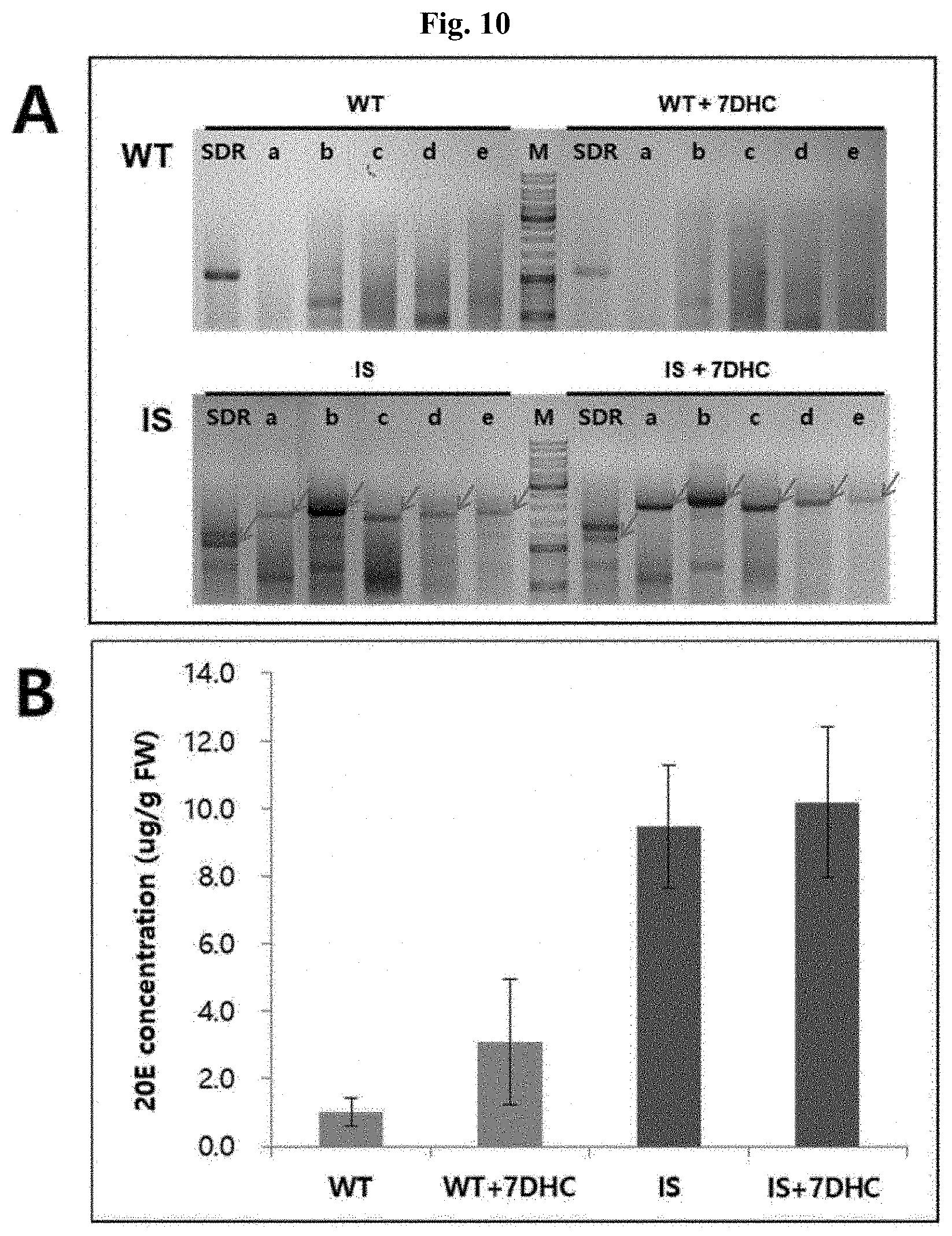
D00011
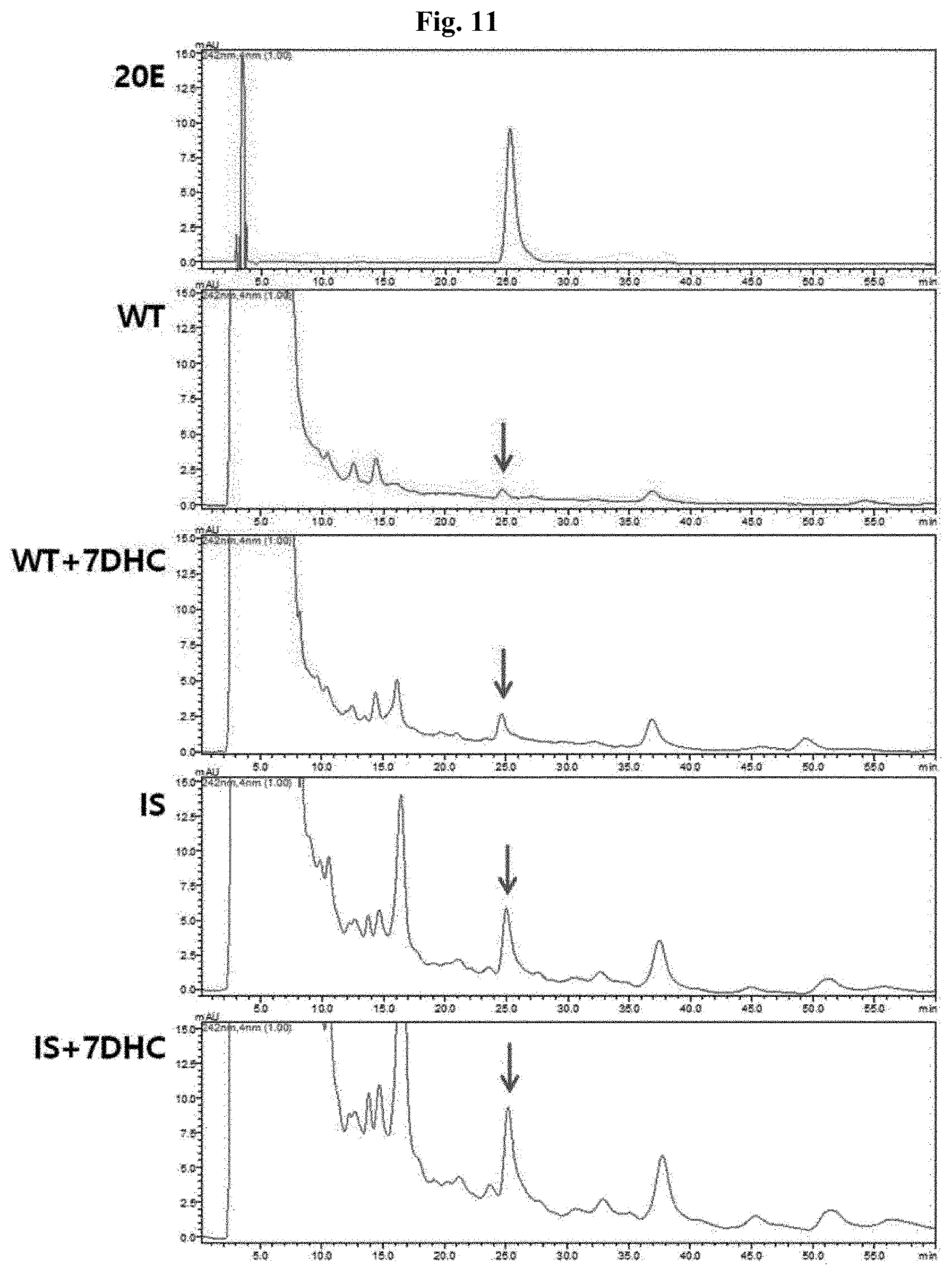
D00012
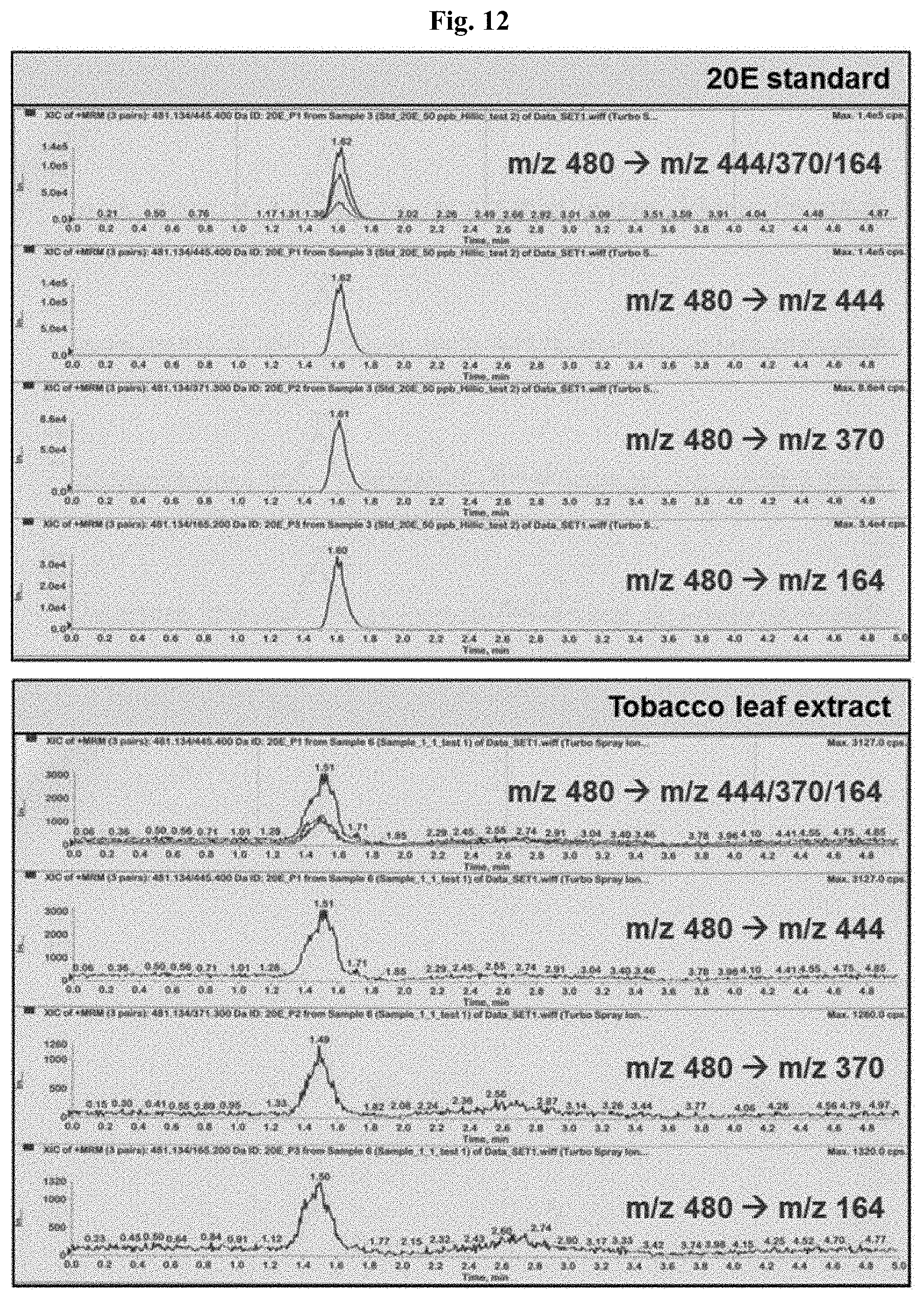
S00001
XML
uspto.report is an independent third-party trademark research tool that is not affiliated, endorsed, or sponsored by the United States Patent and Trademark Office (USPTO) or any other governmental organization. The information provided by uspto.report is based on publicly available data at the time of writing and is intended for informational purposes only.
While we strive to provide accurate and up-to-date information, we do not guarantee the accuracy, completeness, reliability, or suitability of the information displayed on this site. The use of this site is at your own risk. Any reliance you place on such information is therefore strictly at your own risk.
All official trademark data, including owner information, should be verified by visiting the official USPTO website at www.uspto.gov. This site is not intended to replace professional legal advice and should not be used as a substitute for consulting with a legal professional who is knowledgeable about trademark law.